Ukraine
Ukraine (Ukrainian: Україна, romanized: Ukrayina, pronounced [ʊkrɐˈjinɐ] (![]()
Ukraine
| |
|---|---|
Anthem: "Derzhavnyy Hymn Ukrayiny" (English: "State Anthem of Ukraine") | |
.svg.png) .svg.png)
| |
| Capital and largest city | Kiev 49°N 32°E |
| Official languages | Ukrainian |
| Recognised regional languages | Russian, Rusyn, Belarusian, Yiddish |
| Ethnic groups (2001)[1] |
|
| Religion (2018)[2] |
|
| Demonym(s) | Ukrainian |
| Government | Unitary semi-presidential constitutional republic |
| Volodymyr Zelensky | |
| Denys Shmyhal | |
| Dmytro Razumkov | |
| Legislature | Verkhovna Rada |
| Independence from Russia | |
• Autonomy | 23 June 1917 |
| 22 January 1918 | |
| 1 November 1918 | |
| 22 January 1919 | |
| 24 August 1991 | |
| 28 June 1996 | |
| Area | |
• Total | 603,628 km2 (233,062 sq mi) (45th) |
• Water (%) | 7 |
| Population | |
• April 2020 estimate | (excluding Crimea and Sevastopol) (33rd) |
• 2001 census | 48,457,102[1] |
• Density | 73.8/km2 (191.1/sq mi) (115th) |
| GDP (PPP) | 2020 estimate |
• Total | |
• Per capita | |
| GDP (nominal) | 2020 estimate |
• Total | |
• Per capita | |
| Gini (2018) | low · 18th |
| HDI (2018) | high · 88th |
| Currency | Ukrainian hryvnia (₴) (UAH) |
| Time zone | UTC+2[7] (EET) |
| UTC+03 (EEST) | |
| Driving side | right |
| Calling code | +380 |
| ISO 3166 code | UA |
| Internet TLD | |
The territory of modern Ukraine has been inhabited since 32,000 BC. During the Middle Ages, the area was a key centre of East Slavic culture, with the powerful state of Kievan Rus' forming the basis of Ukrainian identity. Following its fragmentation in the 13th century, the territory was contested, ruled and divided by a variety of powers, including the Polish–Lithuanian Commonwealth, Austria-Hungary, the Ottoman Empire and Russia. A Cossack republic emerged and prospered during the 17th and 18th centuries, but its territory was eventually split between Poland and the Russian Empire. After World War II the Western part of Ukraine merged into the Ukrainian Soviet Socialist Republic, and the whole country became a part of the Soviet Union as a single state entity. Ukraine gained its independence in 1991, following the dissolution of the Soviet Union at the end of the Cold War. Before its independence, Ukraine was typically referred to in English as "The Ukraine", but most sources have since moved to drop "the" from the name of Ukraine in all uses.[12]
Following its independence, Ukraine declared itself a neutral state;[13] it formed a limited military partnership with Russia and other CIS countries while also establishing a partnership with NATO in 1994. In 2013, after the government of President Viktor Yanukovych had decided to suspend the Ukraine-European Union Association Agreement and seek closer economic ties with Russia, a several-months-long wave of demonstrations and protests known as the Euromaidan began, which later escalated into the 2014 Ukrainian revolution that led to the overthrow of Yanukovych and the establishment of a new government. These events formed the background for the annexation of Crimea by Russia in March 2014, and the War in Donbass in April 2014. On 1 January 2016, Ukraine applied the economic component of the Deep and Comprehensive Free Trade Area with the European Union.[14]
Ukraine is a developing country and ranks 88th on the Human Development Index. As of 2020, Ukraine is the poorest country in Europe alongside Moldova in terms of GDP per capita. At US$40, it has the lowest median wealth per adult in the world,[note 1][15] and suffers from a very high poverty rate as well as severe corruption.[16] However, because of its extensive fertile farmlands, Ukraine is one of the world's largest grain exporters.[17][18] It also maintains the third-largest military in Europe after the French and Russian Armed Forces.[19] Ukraine is a unitary republic under a semi-presidential system with separate powers: legislative, executive and judicial branches. The country is a member of the United Nations, the Council of Europe, the Organization for Security and Co-operation in Europe (OSCE), the GUAM organization, and one of the founding states of the Commonwealth of Independent States (CIS).
Etymology and orthography
There are different hypotheses as to the etymology of the name Ukraine. According to the older widespread hypothesis, it means "borderland",[20] while some more recent linguistic studies claim a different meaning: "homeland" or "region, country".[21]
"The Ukraine" used to be the usual form in English,[22] but since the Declaration of Independence of Ukraine, "the Ukraine" has become less common in the English-speaking world, and style-guides warn against its use in professional writing.[12][23] According to U.S. ambassador William Taylor, "The Ukraine" now implies disregard for the country's sovereignty.[24] The Ukrainian position is that the usage of "'The Ukraine' is incorrect both grammatically and politically."[25]
History
Early history
Neanderthal settlement in Ukraine is seen in the Molodova archaeological sites (43,000–45,000 BC) which include a mammoth bone dwelling.[26][27] The territory is also considered to be the likely location for the human domestication of the horse.[28][29][30][31]
Modern human settlement in Ukraine and its vicinity dates back to 32,000 BC, with evidence of the Gravettian culture in the Crimean Mountains.[32][33] By 4,500 BC, the Neolithic Cucuteni–Trypillia culture flourished in wide areas of modern Ukraine including Trypillia and the entire Dnieper-Dniester region. During the Iron Age, the land was inhabited by Cimmerians, Scythians, and Sarmatians.[34] Between 700 BC and 200 BC it was part of the Scythian Kingdom, or Scythia.[35]
Beginning in the sixth century BC, colonies of Ancient Greece, Ancient Rome, and the Byzantine Empire, such as Tyras, Olbia, and Chersonesus, were founded on the northeastern shore of the Black Sea. These colonies thrived well into the sixth century AD. The Goths stayed in the area, but came under the sway of the Huns from the 370s AD. In the seventh century AD, the territory of eastern Ukraine was the centre of Old Great Bulgaria. At the end of the century, the majority of Bulgar tribes migrated in different directions, and the Khazars took over much of the land.[36]
In the fifth and sixth centuries, the Antes were located in the territory of what is now Ukraine. The Antes were the ancestors of Ukrainians: White Croats, Severians, Polans, Drevlyans, Dulebes, Ulichians, and Tiverians. Migrations from Ukraine throughout the Balkans established many Southern Slavic nations. Northern migrations, reaching almost to the Ilmen lakes, led to the emergence of the Ilmen Slavs, Krivichs, and Radimichs, the groups ancestral to the Russians. After an Avar raid in 602 and the collapse of the Antes Union, most of these peoples survived as separate tribes until the beginning of the second millennium.[37]
Golden Age of Kiev
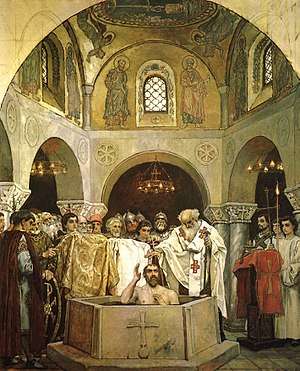
Kievan Rus' was founded in the territory of the Polans, who lived among the rivers Ros, Rosava, and Dnieper. Russian historian Boris Rybakov came from studying the linguistics of Russian chronicles to the conclusion that the Polans union of clans of the mid-Dnieper region called itself by the name of one of its clans, "Ros", that joined the union and was known at least since the 6th century far beyond the Slavic world.[38] The origin of the Kiev princedom is of a big debate and there exist at least three versions depending on interpretations of the chronicles.[39] In general it is believed that "Kievan Rus' included the central, western and northern part of modern Ukraine, Belarus, and the far eastern strip of Poland. According to the Primary Chronicle the Rus' elite initially consisted of Varangians from Scandinavia.[40]
During the 10th and 11th centuries, it became the largest and most powerful state in Europe.[41] It laid the foundation for the national identity of Ukrainians and Russians.[42] Kiev, the capital of modern Ukraine, became the most important city of the Rus'. In 12th–13th centuries on efforts of Yuri the Long Armed, in area of Zalesye were founded several cities similar in name as in Kievan Rus such as Vladimir on the Klyazma/Vladimir of Zalesye[43] (Volodymyr), Galich of Merya (Halych), Pereslavl of Zalesye (Pereyaslav of Ruthenian), Pereslavl of Erzya.
.jpg)
The Varangians later assimilated into the Slavic population and became part of the first Rus' dynasty, the Rurik Dynasty.[42] Kievan Rus' was composed of several principalities ruled by the interrelated Rurikid knyazes ("princes"), who often fought each other for possession of Kiev.[44]
The Golden Age of Kievan Rus' began with the reign of Vladimir the Great (980–1015), who turned Rus' toward Byzantine Christianity. During the reign of his son, Yaroslav the Wise (1019–1054), Kievan Rus' reached the zenith of its cultural development and military power.[42] The state soon fragmented as the relative importance of regional powers rose again. After a final resurgence under the rule of Vladimir II Monomakh (1113–1125) and his son Mstislav (1125–1132), Kievan Rus' finally disintegrated into separate principalities following Mstislav's death.[45]
The 13th-century Mongol invasion devastated Kievan Rus'. Kiev was totally destroyed in 1240.[46] On today's Ukrainian territory, the principalities of Halych and Volodymyr-Volynskyi arose, and were merged into the state of Galicia-Volhynia.[47]
Danylo Romanovych (Daniel I of Galicia or Danylo Halytskyi) son of Roman Mstyslavych, re-united all of south-western Rus', including Volhynia, Galicia and Rus' ancient capital of Kiev. Danylo was crowned by the papal archbishop in Dorohychyn 1253 as the first King of all Rus'. Under Danylo's reign, the Kingdom of Galicia–Volhynia was one of the most powerful states in east central Europe.[48]
Foreign domination

In the mid-14th century, upon the death of Bolesław Jerzy II of Mazovia, king Casimir III of Poland initiated campaigns (1340–1366) to take Galicia-Volhynia. Meanwhile, the heartland of Rus', including Kiev, became the territory of the Grand Duchy of Lithuania, ruled by Gediminas and his successors, after the Battle on the Irpen' River. Following the 1386 Union of Krewo, a dynastic union between Poland and Lithuania, much of what became northern Ukraine was ruled by the increasingly Slavicised local Lithuanian nobles as part of the Grand Duchy of Lithuania. By 1392 the so-called Galicia–Volhynia Wars ended. Polish colonisers of depopulated lands in northern and central Ukraine founded or re-founded many towns. In 1430 Podolia was incorporated under the Crown of the Kingdom of Poland as Podolian Voivodeship. In 1441, in the southern Ukraine, especially Crimea and surrounding steppes, Genghisid prince Haci I Giray founded the Crimean Khanate.[49]
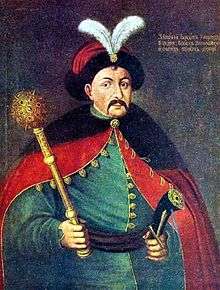
In 1569 the Union of Lublin established the Polish–Lithuanian Commonwealth, and much Ukrainian territory was transferred from Lithuania to the Crown of the Kingdom of Poland, becoming Polish territory de jure. Under the demographic, cultural and political pressure of Polonisation, which began in the late 14th century, many landed gentry of Polish Ruthenia (another name for the land of Rus) converted to Catholicism and became indistinguishable from the Polish nobility.[50] Deprived of native protectors among Rus nobility, the commoners (peasants and townspeople) began turning for protection to the emerging Zaporozhian Cossacks, who by the 17th century became devoutly Orthodox. The Cossacks did not shy from taking up arms against those they perceived as enemies, including the Polish state and its local representatives.[51]
Formed from Golden Horde territory conquered after the Mongol invasion the Crimean Khanate was one of the strongest powers in Eastern Europe until the 18th century; in 1571 it even captured and devastated Moscow.[52] The borderlands suffered annual Tatar invasions. From the beginning of the 16th century until the end of the 17th century, Crimean Tatar slave raiding bands[53] exported about two million slaves from Russia and Ukraine.[54] According to Orest Subtelny, "from 1450 to 1586, eighty-six Tatar raids were recorded, and from 1600 to 1647, seventy."[55] In 1688, Tatars captured a record number of 60,000 Ukrainians.[56] The Tatar raids took a heavy toll, discouraging settlement in more southerly regions where the soil was better and the growing season was longer. The last remnant of the Crimean Khanate was finally conquered by the Russian Empire in 1783.[57]
In the mid-17th century, a Cossack military quasi-state, the Zaporozhian Host, was formed by Dnieper Cossacks and by Ruthenian peasants who had fled Polish serfdom.[58] Poland exercised little real control over this population, but found the Cossacks to be a useful opposing force to the Turks and Tatars,[59] and at times the two were allies in military campaigns.[60] However the continued harsh enserfment of peasantry by Polish nobility and especially the suppression of the Orthodox Church alienated the Cossacks.[59]
The Cossacks sought representation in the Polish Sejm, recognition of Orthodox traditions, and the gradual expansion of the Cossack Registry. These were rejected by the Polish nobility, who dominated the Sejm.[61]
Cossack Hetmanate

In 1648, Bohdan Khmelnytsky and Petro Doroshenko led the largest of the Cossack uprisings against the Commonwealth and the Polish king Treaty of Perpetual Peace (1686).[62] After Khmelnytsky made an entry into Kiev in 1648, where he was hailed liberator of the people from Polish captivity, he founded the Cossack Hetmanate, which existed until 1764 (some sources claim until 1782).
Khmelnytsky deserted by his Tatar allies, suffered a crushing deafeat at the Battle of Berestechko in 1651, and turned to the Russian tsar for help. In 1654, Khmelnytsky was subject to the Pereyaslav Council, forming a military and political alliance with Russia that acknowledged loyalty to the Russian tsar.
In 1657–1686 came "The Ruin", a devastating 30-year war amongst Russia, Poland, the Crimean Khanate, the Ottoman Empire, and Cossacks for control of Ukraine, which occurred at about the same time as the Deluge of Poland. The wars escalated in intensity with hundreds of thousands of deaths. Defeat came in 1686 as the "Treaty of Perpetual Peace" between Russia and Poland divided Ukrainian lands between them.
In 1709, Cossack Hetman Ivan Mazepa (1639–1709) defected to Sweden against Russia in the Great Northern War (1700–1721). Eventually Peter recognized that to consolidate and modernize Russia's political and economic power it was necessary to do away with the Cossack Hetmanate and Ukrainian and Cossack aspirations to autonomy. Mazepa died in exile after fleeing from the Battle of Poltava (1709), where the Swedes and their Cossack allies suffered a catastrophic defeat.

The Constitution of Pylyp Orlyk or Pacts and Constitutions of Rights and Freedoms of the Zaporizhian Host was a 1710 constitutional document written by Hetman Pylyp Orlyk, a Cossack of Ukraine, then within the Polish–Lithuanian Commonwealth.[63] It established a standard for the separation of powers in government between the legislative, executive, and judiciary branches, well before the publication of Montesquieu's The Spirit of the Laws. The Constitution limited the executive authority of the hetman, and established a democratically elected Cossack parliament called the General Council. The Constitution of Pylyp Orlyk was unique for its period, and was one of the first state constitutions in Europe.
The hetmanate was abolished in 1764; the Zaporozhian Sich was abolished in 1775, as Russia centralised control over its lands. As part of the Partitions of Poland in 1772, 1793 and 1795, the Ukrainian lands west of the Dnieper were divided between Russia and Austria. From 1737 to 1834, expansion into the northern Black Sea littoral and the eastern Danube valley was a cornerstone of Russian foreign policy.
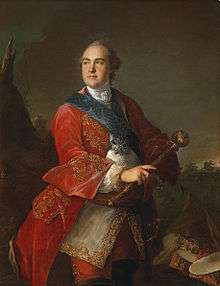
Lithuanians and Poles controlled vast estates in Ukraine, and were a law unto themselves. Judicial rulings from Kraków were routinely flouted, while peasants were heavily taxed and practically tied to the land as serfs Occasionally the landowners battled each other using armies of Ukrainian peasants. The Poles and Lithuanians were Roman Catholics and tried with some success to convert the Orthodox lesser nobility. In 1596, they set up the "Greek-Catholic" or Uniate Church; it dominates western Ukraine to this day. Religious differentiation left the Ukrainian Orthodox peasants leaderless, as they were reluctant to follow the Ukrainian nobles.[64]
Cossacks led an uprising, called Koliyivshchyna, starting in the Ukrainian borderlands of the Polish–Lithuanian Commonwealth in 1768. Ethnicity was one root cause of this revolt, which included the Massacre of Uman that killed tens of thousands of Poles and Jews. Religious warfare also broke out among Ukrainian groups. Increasing conflict between Uniate and Orthodox parishes along the newly reinforced Polish-Russian border on the Dnieper in the time of Catherine the Great set the stage for the uprising. As Uniate religious practices had become more Latinized, Orthodoxy in this region drew even closer into dependence on the Russian Orthodox Church. Confessional tensions also reflected opposing Polish and Russian political allegiances.[65]
After the annexation of Crimea by the Russian Empire in 1783, Novorossiya was settled by Ukrainians and Russians.[66] Despite promises in the Treaty of Pereyaslav, the Ukrainian elite and the Cossacks never received the freedoms and the autonomy they were expecting. However, within the Empire, Ukrainians rose to the highest Russian state and church offices.[a] At a later period, tsarists established a policy of Russification, suppressing the use of the Ukrainian language in print and in public.[67]
19th century, World War I and revolution
In the 19th century, Ukraine was a rural area largely ignored by Russia and Austria. With growing urbanization and modernization, and a cultural trend toward romantic nationalism, a Ukrainian intelligentsia committed to national rebirth and social justice emerged. The serf-turned-national-poet Taras Shevchenko (1814–1861) and the political theorist Mykhailo Drahomanov (1841–1895) led the growing nationalist movement.[68][69]

After the Russo-Turkish War (1768–1774), Catherine the Great and her immediate successors encouraged German immigration into Ukraine and especially into Crimea, to thin the previously dominant Turk population and encourage agriculture.[70] Numerous Ukrainians, Russians, Germans, Bulgarians, Serbs and Greeks moved into the northern Black Sea steppe formerly known as the "Wild Fields".[71][72]
Beginning in the 19th century, there was migration from Ukraine to distant areas of the Russian Empire. According to the 1897 census, there were 223,000 ethnic Ukrainians in Siberia and 102,000 in Central Asia.[73] An additional 1.6 million emigrated to the east in the ten years after the opening of the Trans-Siberian Railway in 1906.[74] Far Eastern areas with an ethnic Ukrainian population became known as Green Ukraine.[75]
Nationalist and socialist parties developed in the late 19th century. Austrian Galicia, under the relatively lenient rule of the Habsburgs, became the centre of the nationalist movement.[76]
Ukrainians entered World War I on the side of both the Central Powers, under Austria, and the Triple Entente, under Russia. 3.5 million Ukrainians fought with the Imperial Russian Army, while 250,000 fought for the Austro-Hungarian Army.[77] Austro-Hungarian authorities established the Ukrainian Legion to fight against the Russian Empire. This became the Ukrainian Galician Army that fought against the Bolsheviks and Poles in the post-World War I period (1919–23). Those suspected of Russophile sentiments in Austria were treated harshly.[78]
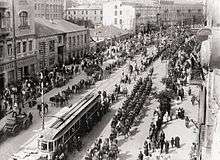
World War I destroyed both empires. The Russian Revolution of 1917 led to the founding of the Soviet Union under the Bolsheviks, and subsequent civil war in Russia. A Ukrainian national movement for self-determination re-emerged, with heavy Communist and Socialist influence. Several Ukrainian states briefly emerged: the internationally recognized Ukrainian People's Republic (UNR, the predecessor of modern Ukraine, was declared on 23 June 1917 proclaimed at first as a part of the Russian Republic; after the Bolshevik Revolution, the Ukrainian People's Republic proclaimed its independence on 25 January 1918), the Hetmanate, the Directorate and the pro-Bolshevik Ukrainian Soviet Socialist Republic (or Soviet Ukraine) successively established territories in the former Russian Empire; while the West Ukrainian People's Republic and the Hutsul Republic emerged briefly in the Ukrainian lands of former Austro-Hungarian territory.[79]
The short lived Act Zluky (Unification Act) was an agreement signed on 22 January 1919 by the Ukrainian People's Republic and the West Ukrainian People's Republic on the St. Sophia Square in Kiev.[80] This led to civil war, and an anarchist movement called the Black Army (later renamed to The Revolutionary Insurrectionary Army of Ukraine) developed in Southern Ukraine under the command of the anarchist Nestor Makhno during the Russian Civil War.[81] They protected the operation of "free soviets" and libertarian communes in the Free Territory, an attempt to form a stateless anarchist society from 1918 to 1921 during the Ukrainian Revolution, fighting both the tsarist White Army under Denikin and later the Red Army under Trotsky, before being defeated by the latter in August 1921.
Poland defeated Western Ukraine in the Polish-Ukrainian War, but failed against the Bolsheviks in an offensive against Kiev. According to the Peace of Riga, western Ukraine was incorporated into Poland, which in turn recognised the Ukrainian Soviet Socialist Republic in March 1919. With establishment of the Soviet power, Ukraine lost half of its territory, while Moldavian autonomy was established on the left bank of the Dniester River. Ukraine became a founding member of the Union of Soviet Socialist Republics in December 1922.[82]
Western Ukraine, Carpathian Ruthenia and Bukovina
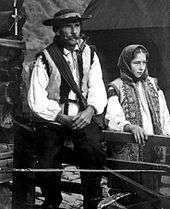
The war in Ukraine continued for another two years; by 1921, however, most of Ukraine had been taken over by the Soviet Union, while Galicia and Volhynia (mostly today's West Ukraine) were incorporated into the Second Polish Republic. Modern-day Bukovina was annexed by Romania and Carpathian Ruthenia was admitted to the Czechoslovak Republic as an autonomy.[83]
A powerful underground Ukrainian nationalist movement arose in eastern Poland in the 1920s and 1930s, which was formed by Ukrainian veterans of the Ukrainian-Soviet war (including Yevhen Konovalets, Andriy Melnyk, and Yuriy Tyutyunyk) and was transformed into the Ukrainian Military Organization and later the Organisation of Ukrainian Nationalists (OUN). The movement attracted a militant following among students. Hostilities between Polish state authorities and the popular movement led to a substantial number of fatalities, and the autonomy which had been promised was never implemented. The pre-war Polish government also exercised anti-Ukrainian sentiment; it restricted rights of people who declared Ukrainian nationality, belonged to the Eastern Orthodox Church and inhabited the Eastern Borderlands.[84][85] The Ukrainian language was restricted in every field possible, especially in governmental institutions, and the term "Ruthenian" was enforced in an attempt to ban the use of the term "Ukrainian".[86] Despite this, a number of Ukrainian parties, the Ukrainian Catholic Church, an active press, and a business sector existed in Poland. Economic conditions improved in the 1920s, but the region suffered from the Great Depression in the early 1930s.[87]
Inter-war Soviet Ukraine
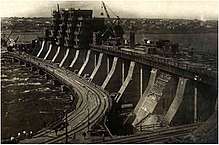
The Russian Civil War devastated the whole Russian Empire including Ukraine. It left over 1.5 million people dead and hundreds of thousands homeless in the former Russian Empire territory. Soviet Ukraine also faced the Russian famine of 1921 (primarily affecting the Russian Volga-Ural region).[88][89] During the 1920s,[90] under the Ukrainisation policy pursued by the national Communist leadership of Mykola Skrypnyk, Soviet leadership encouraged a national renaissance in the Ukrainian culture and language. Ukrainisation was part of the Soviet-wide policy of Korenisation (literally indigenisation).[82] The Bolsheviks were also committed to universal health care, education and social-security benefits, as well as the right to work and housing.[91] Women's rights were greatly increased through new laws.[92] Most of these policies were sharply reversed by the early 1930s after Joseph Stalin became the de facto communist party leader.
Starting from the late 1920s with a centrally planned economy, Ukraine was involved in Soviet industrialisation and the republic's industrial output quadrupled during the 1930s.[82] The peasantry suffered from the programme of collectivisation of agriculture which began during and was part of the first five-year plan and was enforced by regular troops and secret police.[82] Those who resisted were arrested and deported and agricultural productivity greatly declined. As members of the collective farms were sometimes not allowed to receive any grain until unrealistic quotas were met, millions starved to death in a famine known as the Holodomor or the "Great Famine".[93]
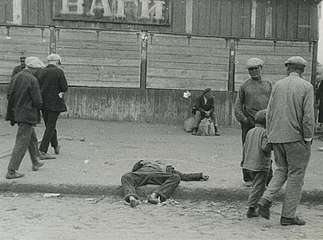
Scholars are divided as to whether this famine fits the definition of genocide, but the Ukrainian parliament and the governments of other countries have acknowledged it as such.[b]
The Communist leadership perceived famine as a means of class struggle and used starvation as a punishment tool to force peasants into collective farms.[94]
Largely the same groups were responsible for the mass killing operations during the civil war, collectivisation, and the Great Terror. These groups were associated with Yefim Yevdokimov (1891–1939) and operated in the Secret Operational Division within General State Political Administration (OGPU) in 1929–31. Yevdokimov transferred into Communist Party administration in 1934, when he became Party secretary for North Caucasus Krai. He appears to have continued advising Joseph Stalin and Nikolai Yezhov on security matters, and the latter relied on Yevdokimov's former colleagues to carry out the mass killing operations that are known as the Great Terror in 1937–38.[95]
On 13 January 2010, Kiev Appellate Court posthumously found Stalin, Kaganovich and other Soviet Communist Party functionaries guilty of genocide against Ukrainians during the Holodomor famine.[96]
World War II

Following the Invasion of Poland in September 1939, German and Soviet troops divided the territory of Poland. Thus, Eastern Galicia and Volhynia with their Ukrainian population became part of Ukraine. For the first time in history, the nation was united.[97][98]
In 1940, the Soviets annexed Bessarabia and northern Bukovina. The Ukrainian SSR incorporated the northern and southern districts of Bessarabia, northern Bukovina, and the Hertsa region. But it ceded the western part of the Moldavian Autonomous Soviet Socialist Republic to the newly created Moldavian Soviet Socialist Republic. These territorial gains of the USSR were internationally recognized by the Paris peace treaties of 1947.
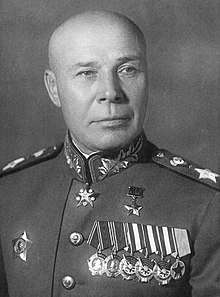
German armies invaded the Soviet Union on 22 June 1941, initiating nearly four years of total war. The Axis initially advanced against desperate but unsuccessful efforts of the Red Army. In the encirclement battle of Kiev, the city was acclaimed as a "Hero City", because of its fierce resistance. More than 600,000 Soviet soldiers (or one-quarter of the Soviet Western Front) were killed or taken captive there, with many suffering severe mistreatment.[99][100]
Although the majority of Ukrainians fought in or alongside the Red Army and Soviet resistance,[101] in Western Ukraine an independent Ukrainian Insurgent Army movement arose (UPA, 1942). Created as armed forces of the underground (Organization of Ukrainian Nationalists, OUN)[102][103] which had developed in interwar Poland as a reactionary nationalist organization. During the interwar period, the Polish government's policies towards the Ukrainian minority were initially very accommodating, however by the late 1930s they became increasingly harsh due to civil unrest. Both organizations, OUN and UPA supported the goal of an independent Ukrainian state on the territory with a Ukrainian ethnic majority. Although this brought conflict with Nazi Germany, at times the Melnyk wing of the OUN allied with the Nazi forces. Also, UPA divisions carried out massacres of ethnic Poles, killing around 100,000 Polish civilians,[104] which brought reprisals.[105] After the war, the UPA continued to fight the USSR until the 1950s.[106][107] At the same time, the Ukrainian Liberation Army, another nationalist movement, fought alongside the Nazis.
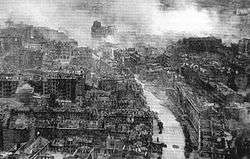
In total, the number of ethnic Ukrainians who fought in the ranks of the Soviet Army is estimated from 4.5 million[101] to 7 million.[108][c] The pro-Soviet partisan guerrilla resistance in Ukraine is estimated to number at 47,800 from the start of occupation to 500,000 at its peak in 1944, with about 50% being ethnic Ukrainians.[109] Generally, the Ukrainian Insurgent Army's figures are unreliable, with figures ranging anywhere from 15,000 to as many as 100,000 fighters.[110][111]
Most of the Ukrainian SSR was organised within the Reichskommissariat Ukraine, with the intention of exploiting its resources and eventual German settlement. Some western Ukrainians, who had only joined the Soviet Union in 1939, hailed the Germans as liberators. Brutal German rule eventually turned their supporters against the Nazi administrators, who made little attempt to exploit dissatisfaction with Stalinist policies.[112] Instead, the Nazis preserved the collective-farm system, carried out genocidal policies against Jews, deported millions of people to work in Germany, and began a depopulation program to prepare for German colonisation.[112] They blockaded the transport of food on the Kiev River.[113]
The vast majority of the fighting in World War II took place on the Eastern Front.[114] By some estimates, 93% of all German casualties took place there.[115] The total losses inflicted upon the Ukrainian population during the war are estimated at about 6 million,[116][117] including an estimated one and a half million Jews killed by the Einsatzgruppen,[118] sometimes with the help of local collaborators. Of the estimated 8.6 million Soviet troop losses,[119][120][121] 1.4 million were ethnic Ukrainians.[119][121][c][d] Victory Day is celebrated as one of ten Ukrainian national holidays.[122]
Post-World War II
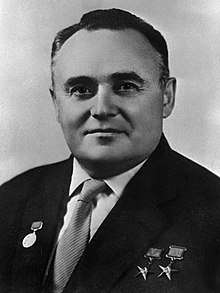
The republic was heavily damaged by the war, and it required significant efforts to recover. More than 700 cities and towns and 28,000 villages were destroyed.[123] The situation was worsened by a famine in 1946–47, which was caused by a drought and the wartime destruction of infrastructure. The death toll of this famine varies, with even the lowest estimate in the tens of thousands.[124][125][126] In 1945, the Ukrainian SSR became one of the founding members of the United Nations organization,[127] part of a special agreement at the Yalta Conference.[128]
Post-war ethnic cleansing occurred in the newly expanded Soviet Union. As of 1 January 1953, Ukrainians were second only to Russians among adult "special deportees", comprising 20% of the total.[129] In addition, over 450,000 ethnic Germans from Ukraine and more than 200,000 Crimean Tatars were victims of forced deportations.[129]

Following the death of Stalin in 1953, Nikita Khrushchev became the new leader of the USSR. Having served as First Secretary of the Communist Party of Ukrainian SSR in 1938–49, Khrushchev was intimately familiar with the republic; after taking power union-wide, he began to emphasize "the friendship" between the Ukrainian and Russian nations. In 1954, the 300th anniversary of the Treaty of Pereyaslav was widely celebrated. Crimea was transferred from the Russian SFSR to the Ukrainian SSR.[130]
By 1950, the republic had fully surpassed pre-war levels of industry and production.[131] During the 1946–1950 five-year plan, nearly 20% of the Soviet budget was invested in Soviet Ukraine, a 5% increase from pre-war plans. As a result, the Ukrainian workforce rose 33.2% from 1940 to 1955 while industrial output grew 2.2 times in that same period.
Soviet Ukraine soon became a European leader in industrial production,[132] and an important centre of the Soviet arms industry and high-tech research. Such an important role resulted in a major influence of the local elite. Many members of the Soviet leadership came from Ukraine, most notably Leonid Brezhnev. He later ousted Khrushchev and became the Soviet leader from 1964 to 1982. Many prominent Soviet sports players, scientists, and artists came from Ukraine.
On 26 April 1986, a reactor in the Chernobyl Nuclear Power Plant exploded, resulting in the Chernobyl disaster, the worst nuclear reactor accident in history.[133] This was the only accident to receive the highest possible rating of 7 by the International Nuclear Event Scale, indicating a "major accident", until the Fukushima Daiichi nuclear disaster in March 2011.[134] At the time of the accident, 7 million people lived in the contaminated territories, including 2.2 million in Ukraine.[135]
After the accident, the new city of Slavutych was built outside the exclusion zone to house and support the employees of the plant, which was decommissioned in 2000. A report prepared by the International Atomic Energy Agency and World Health Organization attributed 56 direct deaths to the accident and estimated that there may have been 4,000 extra cancer deaths.[136]
Independence
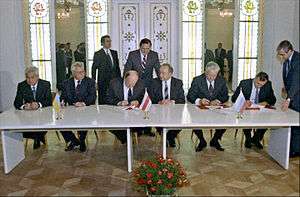
On 16 July 1990, the new parliament adopted the Declaration of State Sovereignty of Ukraine.[137] This established the principles of the self-determination, democracy, independence, and the priority of Ukrainian law over Soviet law. A month earlier, a similar declaration was adopted by the parliament of the Russian SFSR. This started a period of confrontation with the central Soviet authorities. In August 1991, a faction among the Communist leaders of the Soviet Union attempted a coup to remove Mikhail Gorbachev and to restore the Communist party's power. After it failed, on 24 August 1991 the Ukrainian parliament adopted the Act of Independence.[138]
A referendum and the first presidential elections took place on 1 December 1991. More than 90% of the electorate expressed their support for the Act of Independence, and they elected the chairman of the parliament, Leonid Kravchuk as the first President of Ukraine. At the meeting in Brest, Belarus on 8 December, followed by the Alma Ata meeting on 21 December, the leaders of Belarus, Russia, and Ukraine formally dissolved the Soviet Union and formed the Commonwealth of Independent States (CIS).[139] On 26 December 1991 the Council of Republics of the USSR Supreme Council adapted declaration "In regards to creation of the Commonwealth of Independent States" (Russian: В связи с созданием Содружества Независимых Государств) which de jure dissolved the Soviet Union and the Soviet flag was lowered over the Kremlin.[140]
Ukraine was initially viewed as having favourable economic conditions in comparison to the other regions of the Soviet Union.[141] However, the country experienced deeper economic slowdown than some of the other former Soviet Republics. During the recession, Ukraine lost 60% of its GDP from 1991 to 1999,[142][143] and suffered five-digit inflation rates.[144] Dissatisfied with the economic conditions, as well as the amounts of crime and corruption in Ukraine, Ukrainians protested and organized strikes.[145]
The Ukrainian economy stabilized by the end of the 1990s. A new currency, the hryvnia, was introduced in 1996. After 2000, the country enjoyed steady real economic growth averaging about seven percent annually.[146][147] A new Constitution of Ukraine was adopted under second President Leonid Kuchma in 1996, which turned Ukraine into a semi-presidential republic and established a stable political system. Kuchma was, however, criticised by opponents for corruption, electoral fraud, discouraging free speech and concentrating too much power in his office.[148] Ukraine also pursued full nuclear disarmament, giving up the third largest nuclear weapons stockpile in the world and dismantling or removing all strategic bombers on its territory in exchange for various assurances (main article: Nuclear weapons and Ukraine).[149]
Orange Revolution
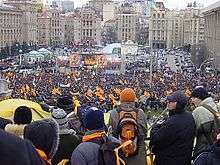
In 2004, Viktor Yanukovych, then Prime Minister, was declared the winner of the presidential elections, which had been largely rigged, as the Supreme Court of Ukraine later ruled.[150] The results caused a public outcry in support of the opposition candidate, Viktor Yushchenko, who challenged the outcome. During the tumultuous months of the revolution, candidate Yushchenko suddenly became gravely ill, and was soon found by multiple independent physician groups to have been poisoned by TCDD dioxin.[151][152] Yushchenko strongly suspected Russian involvement in his poisoning.[153] All of this eventually resulted in the peaceful Orange Revolution, bringing Viktor Yushchenko and Yulia Tymoshenko to power, while casting Viktor Yanukovych in opposition.[154]
.jpg)
Activists of the Orange Revolution were funded and trained in tactics of political organisation and nonviolent resistance by Western pollsters and professional consultants who were partly funded by Western government and non-government agencies but received most of their funding from domestic sources.[nb 1][155] According to The Guardian, the foreign donors included the U.S. State Department and USAID along with the National Democratic Institute for International Affairs, the International Republican Institute, the NGO Freedom House and George Soros's Open Society Institute.[156] The National Endowment for Democracy has supported democracy-building efforts in Ukraine since 1988.[157] Writings on nonviolent struggle by Gene Sharp contributed in forming the strategic basis of the student campaigns.[158]
Russian authorities provided support through advisers such as Gleb Pavlovsky, consulting on blackening the image of Yushchenko through the state media, pressuring state-dependent voters to vote for Yanukovych and on vote-rigging techniques such as multiple 'carousel voting' and 'dead souls' voting.[155]
Yanukovych returned to power in 2006 as Prime Minister in the Alliance of National Unity,[159] until snap elections in September 2007 made Tymoshenko Prime Minister again.[160] Amid the 2008–09 Ukrainian financial crisis the Ukrainian economy plunged by 15%.[161] Disputes with Russia briefly stopped all gas supplies to Ukraine in 2006 and again in 2009, leading to gas shortages in other countries.[162][163] Viktor Yanukovych was elected President in 2010 with 48% of votes.[164]
Euromaidan and 2014 revolution
The Euromaidan (Ukrainian: Євромайдан, literally "Eurosquare") protests started in November 2013 after the president, Viktor Yanukovych, began moving away from an association agreement that had been in the works with the European Union and instead chose to establish closer ties with the Russian Federation.[165][166][167] Some Ukrainians took to the streets to show their support for closer ties with Europe.[168] Meanwhile, in the predominantly Russian-speaking east, a large portion of the population opposed the Euromaidan protests, instead supporting the Yanukovych government.[169] Over time, Euromaidan came to describe a wave of demonstrations and civil unrest in Ukraine,[170] the scope of which evolved to include calls for the resignation of President Yanukovych and his government.[171]
Violence escalated after 16 January 2014 when the government accepted new Anti-Protest Laws. Violent anti-government demonstrators occupied buildings in the centre of Kiev, including the Justice Ministry building, and riots left 98 dead with approximately fifteen thousand injured and 100 considered missing[172][173][174][175] from 18 to 20 February.[176][177] On 21 February, President Yanukovych signed a compromise deal with opposition leaders that promised constitutional changes to restore certain powers to Parliament and called for early elections to be held by December.[178] However, Members of Parliament voted on 22 February to remove the president and set an election for 25 May to select his replacement.[179] Petro Poroshenko, running on a pro-European Union platform, won with over fifty percent of the vote, therefore not requiring a run-off election.[180][181][182] Upon his election, Poroshenko announced that his immediate priorities would be to take action in the civil unrest in Eastern Ukraine and mend ties with the Russian Federation.[180][181][182] Poroshenko was inaugurated as president on 7 June 2014, as previously announced by his spokeswoman Irina Friz in a low-key ceremony without a celebration on Kiev's Maidan Nezalezhnosti (Independence Square, the centre of the Euromaidan protests[183]) for the ceremony.[184][185] In October 2014 Parliament elections, Petro Poroshenko Bloc "Solidarity" won 132 of the 423 contested seats.[186]
Civil unrest, Russian intervention, and annexation of Crimea
The ousting[187] of Yanukovych prompted Vladimir Putin to begin preparations to annex Crimea on 23 February 2014.[188][189] Using the Russian naval base at Sevastopol as cover, Putin directed Russian troops and intelligence agents to disarm Ukrainian forces and take control of Crimea.[190][191][192][193] After the troops entered Crimea,[194] a controversial referendum was held on 16 March 2014 and the official result was that 97 percent wished to join with Russia.[195] On 18 March 2014, Russia and the self-proclaimed Republic of Crimea signed a treaty of accession of the Republic of Crimea and Sevastopol in the Russian Federation. The UN general assembly responded by passing resolution 68/262 that the referendum was invalid and supporting the territorial integrity of Ukraine.[196]
Separately, in the Donetsk and Luhansk regions, armed men declaring themselves as local militia supported with pro-Russian protesters[197] seized government buildings, police and special police stations in several cities and held unrecognised status referendums.[198] The insurgency was led by Russian emissaries Igor Girkin[199] and Alexander Borodai[200] as well as militants from Russia, such as Arseny Pavlov.[201]
Talks in Geneva between the EU, Russia, Ukraine and USA yielded a Joint Diplomatic Statement referred to as the 2014 Geneva Pact[202] in which the parties requested that all unlawful militias lay down their arms and vacate seized government buildings, and also establish a political dialogue that could lead to more autonomy for Ukraine's regions. When Petro Poroshenko won the presidential election held on 25 May 2014, he vowed to continue the military operations by the Ukrainian government forces to end the armed insurgency.[203] More than 9,000 people have been killed in the military campaign.
In August 2014, a bilateral commission of leading scholars from the United States and Russia issued the Boisto Agenda indicating a 24-step plan to resolve the crisis in Ukraine.[204] The Boisto Agenda was organized into five imperative categories for addressing the crisis requiring stabilization identified as: (1) Elements of an Enduring, Verifiable Ceasefire; (2) Economic Relations; (3) Social and Cultural Issues; (4) Crimea; and, (5) International Status of Ukraine.[204] In late 2014, Ukraine ratified the Ukraine–European Union Association Agreement, which Poroshenko described as Ukraine's "first but most decisive step" towards EU membership.[205] Poroshenko also set 2020 as the target for EU membership application.[206]
.jpg)
In February 2015, after a summit hosted in Belarus, Poroshenko negotiated a ceasefire with the separatist troops. This included conditions such as the withdrawal of heavy weaponry from the front line and decentralisation of rebel regions by the end of 2015. It also included conditions such as Ukrainian control of the border with Russia in 2015 and the withdrawal of all foreign troops from Ukrainian territory. The ceasefire began at midnight on 15 February 2015. Participants in this ceasefire also agreed to attend regular meetings to ensure that the agreement is respected.[207]
On 1 January 2016, Ukraine joined the Deep and Comprehensive Free Trade Area with European Union,[14] which aims to modernize and develop Ukraine's economy, governance and rule of law to EU standards and gradually increase integration with the EU Internal market.[208] Then, on 11 May 2017 the European Union approved visa-free travel for Ukrainian citizens: this took effect from 11 June entitling Ukrainians to travel to the Schengen area for tourism, family visits and business reasons, with the only document required being a valid biometric passport.[209]
COVID-19
The first case of COVID-19 in Ukraine was recorded on 3 March.[210] On 13 March, the National Bank of Ukraine cut interest rates from 11% to 10% to help stop the coronavirus panic.[211] On 17 March the passage of Law No. 3219, "On Amending Certain Legislative Acts of Ukraine aimed at Preventing the Occurrence and Spread of Coronavirus Disease (COVID-19)" modified the Criminal Code of Ukraine to include rules of behaviour designed to halt the spread of the disease,[212][213] and attributed the measures in law to force majeure;[212] a total of 344 deputies out of 450 in the Verkhovna Rada voted in favour of Law No. 3219.[212] On 17 March, the international border was closed to foreigners.[214] Other measures included shuttering, at least until 3 April, all "cafes, restaurants, gyms, shopping malls, and entertainment venues",[214] the Ukrzaliznytsia passenger rail service,[215] all domestic flights, and public intercity transportation such as the metro in Kiev, Dnipro, and Kharkiv.[214] The ban on travel in the Kiev metro caused chaos, as commuters were forced to assemble instead at bus stops.[216] The government also placed on the right to assembly a limit of 10 individuals.[214] As of 19 March, the number of infections had risen to 21, and three deaths had been reported.[214] On 22 March, Zelensky asked IMF Managing Director Kristalina Georgieva for permission to participate in the $1 trillion IMF coronavirus bailout fund.[217]
On 29 May, Ukraine opened its borders with its neighbours in the EU and Moldova, but not with Belarus and Russia.[218]
Geography

At 603,628 square kilometres (233,062 sq mi) and with a coastline of 2,782 kilometres (1,729 mi), Ukraine is the second-largest country by area in Europe, and the world's 46th-largest country.[41] It lies between latitudes 44° and 53° N, and longitudes 22° and 41° E.
The landscape of Ukraine consists mostly of fertile plains (or steppes) and plateaus, crossed by rivers such as the Dnieper (Dnipro), Seversky Donets, Dniester and the Southern Bug as they flow south into the Black Sea and the smaller Sea of Azov. To the southwest, the delta of the Danube forms the border with Romania. Ukraine's various regions have diverse geographic features ranging from the highlands to the lowlands. The country's only mountains are the Carpathian Mountains in the west, of which the highest is the Hora Hoverla at 2,061 metres (6,762 ft), and the Crimean Mountains on Crimea, in the extreme south along the coast.[219] However Ukraine also has a number of highland regions such as the Volyn-Podillia Upland (in the west) and the Near-Dnipro Upland (on the right bank of Dnieper); to the east there are the south-western spurs of the Central Russian Upland over which runs the border with the Russian Federation. Near the Sea of Azov can be found the Donets Ridge and the Near Azov Upland. The snow melt from the mountains feeds the rivers, and natural changes in altitude form sudden drops in elevation and give rise to waterfalls.
Significant natural resources in Ukraine include iron ore, coal, manganese, natural gas, oil, salt, sulphur, graphite, titanium, magnesium, kaolin, nickel, mercury, timber and an abundance of arable land. Despite this, the country faces a number of major environmental issues such as inadequate supplies of potable water; air- and water-pollution and deforestation, as well as radiation contamination in the north-east from the 1986 accident at the Chernobyl Nuclear Power Plant. Recycling toxic household waste is still in its infancy in Ukraine.[220]
Soil

From northwest to southeast the soils of Ukraine may be divided into three major aggregations:[221]
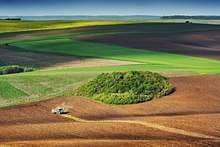
- a zone of sandy podzolized soils
- a central belt consisting of the extremely fertile Ukrainian black earth (chernozems)
- a zone of chestnut and salinized soils
As much as two-thirds of the country's surface land consists of the so-called black earth, a resource that has made Ukraine one of the most fertile regions in the world and well known as a "breadbasket".[222] These soils may be divided into three broad groups:
- in the north a belt of the so-called deep chernozems, about 5 feet (1.5 metres) thick and rich in humus
- south and east of the former, a zone of prairie, or ordinary, chernozems, which are equally rich in humus but only about 3 feet (0.91 metres) thick
- the southernmost belt, which is even thinner and has still less humus
Interspersed in various uplands and along the northern and western perimeters of the deep chernozems are mixtures of gray forest soils and podzolized black-earth soils, which together occupy much of Ukraine's remaining area. All these soils are very fertile when sufficient water is available. However, their intensive cultivation, especially on steep slopes, has led to widespread soil erosion and gullying.
The smallest proportion of the soil cover consists of the chestnut soils of the southern and eastern regions. They become increasingly salinized to the south as they approach the Black Sea.[221]
Climate

Ukraine has a mostly temperate climate, with the exception of the southern coast of Crimea which has a subtropical climate.[223] The climate is influenced by moderately warm, humid air coming from the Atlantic Ocean.[224] Average annual temperatures range from 5.5–7 °C (41.9–44.6 °F) in the north, to 11–13 °C (51.8–55.4 °F) in the south.[224] Precipitation is disproportionately distributed; it is highest in the west and north and lowest in the east and southeast.[224] Western Ukraine, particularly in the Carpathian Mountains, receives around 1,200 millimetres (47.2 in) of precipitation annually, while Crimea and the coastal areas of the Black Sea receive around 400 millimetres (15.7 in).[224]
Biodiversity
Ukraine is home to a diverse assemblage of animals, fungi, microorganisms and plants.
Animals
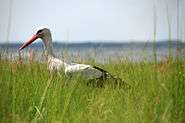
Ukraine is divided into two main zoological areas. One of these areas, in the west of the country, is made up of the borderlands of Europe, where there are species typical of mixed forests, the other is located in eastern Ukraine, where steppe-dwelling species thrive. In the forested areas of the country it is not uncommon to find lynxes, wolves, wild boar and martens, as well as many other similar species; this is especially true of the Carpathian Mountains, where many predatory mammals make their home, as well as a contingent of brown bears. Around Ukraine's lakes and rivers beavers, otters and mink make their home, whilst in the waters carp, bream and catfish are the most commonly found species of fish. In the central and eastern parts of the country, rodents such as hamsters and gophers are found in large numbers.
Fungi
More than 6,600 species of fungi (including lichen-forming species) have been recorded from Ukraine,[225][226] but this number is far from complete. The true total number of fungal species occurring in Ukraine, including species not yet recorded, is likely to be far higher, given the generally accepted estimate that only about 7% of all fungi worldwide have so far been discovered.[227] Although the amount of available information is still very small, a first effort has been made to estimate the number of fungal species endemic to Ukraine, and 2217 such species have been tentatively identified.[228]
Politics
Ukraine is a republic under a mixed semi-parliamentary semi-presidential system with separate legislative, executive, and judicial branches.
Constitution of Ukraine
With the proclamation of its independence on 24 August 1991, and adoption of a constitution on 28 June 1996, Ukraine became a semi-presidential republic. However, in 2004, deputies introduced changes to the Constitution, which tipped the balance of power in favour of a parliamentary system. From 2004 to 2010, the legitimacy of the 2004 Constitutional amendments had official sanction, both with the Constitutional Court of Ukraine, and most major political parties.[233] Despite this, on 30 September 2010 the Constitutional Court ruled that the amendments were null and void, forcing a return to the terms of the 1996 Constitution and again making Ukraine's political system more presidential in character.
The ruling on the 2004 Constitutional amendments became a major topic of political discourse. Much of the concern was based on the fact that neither the Constitution of 1996 nor the Constitution of 2004 provided the ability to "undo the Constitution", as the decision of the Constitutional Court would have it, even though the 2004 constitution arguably has an exhaustive list of possible procedures for constitutional amendments (articles 154–159). In any case, the current Constitution could be modified by a vote in Parliament.[233][234][235]
On 21 February 2014 an agreement between President Viktor Yanukovych and opposition leaders saw the country return to the 2004 Constitution. The historic agreement, brokered by the European Union, followed protests that began in late November 2013 and culminated in a week of violent clashes in which scores of protesters were killed. In addition to returning the country to the 2004 Constitution, the deal provided for the formation of a coalition government, the calling of early elections, and the release of former Prime Minister Yulia Tymoshenko from prison.[236] A day after the agreement was reached the Ukraine parliament dismissed Yanukovych and installed its speaker Oleksandr Turchynov as interim president[237] and Arseniy Yatsenyuk as the Prime Minister of Ukraine.[238]
President, parliament and government
 |
.jpg) |
| Volodymyr Zelensky President |
Denys Shmyhal Prime Minister |
The President is elected by popular vote for a five-year term and is the formal head of state.[239] Ukraine's legislative branch includes the 450-seat unicameral parliament, the Verkhovna Rada.[240] The parliament is primarily responsible for the formation of the executive branch and the Cabinet of Ministers, headed by the Prime Minister.[241] However, the President still retains the authority to nominate the Ministers of the Foreign Affairs and of Defence for parliamentary approval, as well as the power to appoint the Prosecutor General and the head of the Security Service.

Laws, acts of the parliament and the cabinet, presidential decrees, and acts of the Crimean parliament may be abrogated by the Constitutional Court, should they be found to violate the constitution. Other normative acts are subject to judicial review. The Supreme Court is the main body in the system of courts of general jurisdiction. Local self-government is officially guaranteed. Local councils and city mayors are popularly elected and exercise control over local budgets. The heads of regional and district administrations are appointed by the President in accordance with the proposals of the Prime Minister. This system virtually requires an agreement between the President and the Prime Minister, and has in the past led to problems, such as when President Yushchenko exploited a perceived loophole by appointing so-called 'temporarily acting' officers, instead of actual governors or local leaders, thus evading the need to seek a compromise with the Prime Minister. This practice was controversial and was subject to Constitutional Court review.
Ukraine has many political parties, many of which have tiny memberships and are unknown to the general public. Small parties often join in multi-party coalitions (electoral blocs) for the purpose of participating in parliamentary elections.
Courts and law enforcement
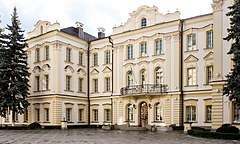
The courts enjoy legal, financial and constitutional freedom guaranteed by Ukrainian law since 2002. Judges are largely well protected from dismissal (except in the instance of gross misconduct). Court justices are appointed by presidential decree for an initial period of five years, after which Ukraine's Supreme Council confirms their positions for life. Although there are still problems, the system is considered to have been much improved since Ukraine's independence in 1991. The Supreme Court is regarded as an independent and impartial body, and has on several occasions ruled against the Ukrainian government. The World Justice Project ranks Ukraine 66 out of 99 countries surveyed in its annual Rule of Law Index.[242]
Prosecutors in Ukraine have greater powers than in most European countries, and according to the European Commission for Democracy through Law 'the role and functions of the Prosecutor's Office is not in accordance with Council of Europe standards".[243] The criminal judicial system maintains an average conviction rate of over 99%,[244] equal to the conviction rate of the Soviet Union, with[245] suspects often being incarcerated for long periods before trial.[246] On 24 March 2010, President Yanukovych formed an expert group to make recommendations how to "clean up the current mess and adopt a law on court organization".[246] One day later, he stated "We can no longer disgrace our country with such a court system."[246] The criminal judicial system and the prison system of Ukraine remain quite punitive.
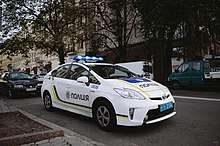
Since 1 January 2010 it has been permissible to hold court proceedings in Russian by mutual consent of the parties. Citizens unable to speak Ukrainian or Russian may use their native language or the services of a translator.[247][248] Previously all court proceedings had to be held in Ukrainian.
Law enforcement agencies in Ukraine are organised under the authority of the Ministry of Internal Affairs. They consist primarily of the national police force (Мiлiцiя) and various specialised units and agencies such as the State Border Guard and the Coast Guard services. Law enforcement agencies, particularly the police, faced criticism for their heavy handling of the 2004 Orange Revolution. Many thousands of police officers were stationed throughout the capital, primarily to dissuade protesters from challenging the state's authority but also to provide a quick reaction force in case of need; most officers were armed.[249] Bloodshed was only avoided when Lt. Gen. Sergei Popkov heeded his colleagues' calls to withdraw.
The Ministry of Internal Affairs is also responsible for the maintenance of the State Security Service; Ukraine's domestic intelligence agency, which has on occasion been accused of acting like a secret police force serving to protect the country's political elite from media criticism. On the other hand, however, it is widely accepted that members of the service provided vital information about government plans to the leaders of the Orange Revolution to prevent the collapse of the movement.
Foreign relations
In 1999–2001, Ukraine served as a non-permanent member of the UN Security Council. Historically, Soviet Ukraine joined the United Nations in 1945 as one of the original members following a Western compromise with the Soviet Union, which had asked for seats for all 15 of its union republics. Ukraine has consistently supported peaceful, negotiated settlements to disputes. It has participated in the quadripartite talks on the conflict in Moldova and promoted a peaceful resolution to conflict in the post-Soviet state of Georgia. Ukraine also has made a substantial contribution to UN peacekeeping operations since 1992.
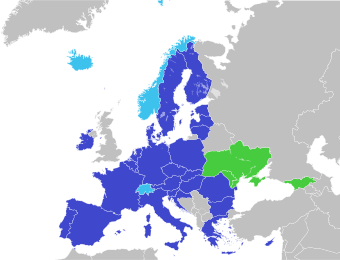
Ukraine currently considers Euro-Atlantic integration its primary foreign policy objective,[250] but in practice it has always balanced its relationship with the European Union and the United States with strong ties to Russia. The European Union's Partnership and Cooperation Agreement (PCA) with Ukraine went into force on 1 March 1998. The European Union (EU) has encouraged Ukraine to implement the PCA fully before discussions begin on an association agreement, issued at the EU Summit in December 1999 in Helsinki, recognizes Ukraine's long-term aspirations but does not discuss association. On 31 January 1992, Ukraine joined the then-Conference on Security and Cooperation in Europe (now the Organization for Security and Cooperation in Europe (OSCE)), and on 10 March 1992, it became a member of the North Atlantic Cooperation Council. Ukraine–NATO relations are close and the country has declared interest in eventual membership.[250] This was removed from the government's foreign policy agenda upon election of Viktor Yanukovych to the presidency, in 2010.[250] But after February 2014's Yanukovych ouster and the (denied by Russia) following Russian military intervention in Ukraine Ukraine renewed its drive for NATO membership.[250] Ukraine is the most active member of the Partnership for Peace (PfP). All major political parties in Ukraine support full eventual integration into the European Union. The Association Agreement with the EU was expected to be signed and put into effect by the end of 2011, but the process was suspended by 2012 because of the political developments of that time.[251] The Association Agreement between Ukraine and the European Union was signed in 2014.[252]
Ukraine long had close ties with all its neighbours, but Russia–Ukraine relations became difficult in 2014 by the annexation of Crimea, energy dependence and payment disputes. There are also tensions with Poland[253] and Hungary.[254]
The Deep and Comprehensive Free Trade Area (DCFTA), which entered into force in January 2016 following the ratification of the Ukraine–European Union Association Agreement, formally integrates Ukraine into the European Single Market and the European Economic Area.[255][256] Ukraine receives further support and assistance for its EU-accession aspirations from the International Visegrád Fund of the Visegrád Group that consists of Central European EU members the Czech Republic, Poland, Hungary and Slovakia.[257]
Administrative divisions
The system of Ukrainian subdivisions reflects the country's status as a unitary state (as stated in the country's constitution) with unified legal and administrative regimes for each unit.
Including Sevastopol and the Autonomous Republic of Crimea that were annexed by the Russian Federation in 2014, Ukraine consists of 27 regions: twenty-four oblasts (provinces), one autonomous republic (Autonomous Republic of Crimea), and two cities of special status – Kiev, the capital, and Sevastopol. The 24 oblasts and Crimea are subdivided into 136[258] raions (districts) and city municipalities of regional significance, or second-level administrative units.
Populated places in Ukraine are split into two categories: urban and rural. Urban populated places are split further into cities and urban-type settlements (a Soviet administrative invention), while rural populated places consist of villages and settlements (a generally used term). All cities have certain degree of self-rule depending on their significance such as national significance (as in the case of Kiev and Sevastopol), regional significance (within each oblast or autonomous republic) or district significance (all the rest of cities). A city's significance depends on several factors such as its population, socio-economic and historical importance, infrastructure and others.
|
| |
Armed forces

After the dissolution of the Soviet Union, Ukraine inherited a 780,000-man military force on its territory, equipped with the third-largest nuclear weapons arsenal in the world.[259][260] In May 1992, Ukraine signed the Lisbon Protocol in which the country agreed to give up all nuclear weapons to Russia for disposal and to join the Nuclear Non-Proliferation Treaty as a non-nuclear weapon state. Ukraine ratified the treaty in 1994, and by 1996 the country became free of nuclear weapons.[259]
Ukraine took consistent steps toward reduction of conventional weapons. It signed the Treaty on Conventional Armed Forces in Europe, which called for reduction of tanks, artillery, and armoured vehicles (army forces were reduced to 300,000). The country plans to convert the current conscript-based military into a professional volunteer military.[261]
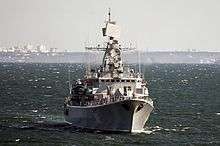
Ukraine has been playing an increasingly larger role in peacekeeping operations. On Friday 3 January 2014, the Ukrainian frigate Hetman Sagaidachniy joined the European Union's counter piracy Operation Atalanta and will be part of the EU Naval Force off the coast of Somalia for two months.[262] Ukrainian troops are deployed in Kosovo as part of the Ukrainian-Polish Battalion.[263] A Ukrainian unit was deployed in Lebanon, as part of UN Interim Force enforcing the mandated ceasefire agreement. There was also a maintenance and training battalion deployed in Sierra Leone. In 2003–05, a Ukrainian unit was deployed as part of the Multinational force in Iraq under Polish command. The total Ukrainian armed forces deployment around the world is 562 servicemen.[264]
Military units of other states participate in multinational military exercises with Ukrainian forces in Ukraine regularly, including U.S. military forces.[265]
Following independence, Ukraine declared itself a neutral state.[13] The country has had a limited military partnership with Russian Federation, other CIS countries and a partnership with NATO since 1994. In the 2000s, the government was leaning towards NATO, and a deeper cooperation with the alliance was set by the NATO-Ukraine Action Plan signed in 2002. It was later agreed that the question of joining NATO should be answered by a national referendum at some point in the future.[261] Recently deposed President Viktor Yanukovych considered the current level of co-operation between Ukraine and NATO sufficient, and was against Ukraine joining NATO. During the 2008 Bucharest summit, NATO declared that Ukraine would eventually become a member of NATO when it meets the criteria for the accession.
Economy
_in_2016.png)
In Soviet times, the economy of Ukraine was the second largest in the Soviet Union, being an important industrial and agricultural component of the country's planned economy.[41] With the dissolution of the Soviet system, the country moved from a planned economy to a market economy. The transition was difficult for the majority of the population which plunged into poverty.[266] Ukraine's economy contracted severely in the years after the Soviet dissolution. Day-to-day life for the average person living in Ukraine was a struggle. A significant number of citizens in rural Ukraine survived by growing their own food, often working two or more jobs and buying the basic necessities through the barter economy.[267]
In 1991, the government liberalised most prices to combat widespread product shortages, and was successful in overcoming the problem. At the same time, the government continued to subsidise state-run industries and agriculture by uncovered monetary emission. The loose monetary policies of the early 1990s pushed inflation to hyperinflationary levels. For the year 1993, Ukraine holds the world record for inflation in one calendar year.[268] Those living on fixed incomes suffered the most.[82] Prices stabilised only after the introduction of new currency, the hryvnia, in 1996. The country was also slow in implementing structural reforms. Following independence, the government formed a legal framework for privatisation. However, widespread resistance to reforms within the government and from a significant part of the population soon stalled the reform efforts. Many state-owned enterprises were exempt from privatisation.
In the meantime, by 1999, the GDP had fallen to less than 40% of the 1991 level.[269] It recovered considerably in the following years.[270] [271] Ukraine was hit by the economic crisis of 2008 and in November 2008, the IMF approved a stand-by loan of $16.5 billion for the country.[272]
In 2019 the average nominal salary in Ukraine reached 10,000 hryvnias per month or around €300[273], while in 2018, Ukraine's median wealth per adult was $40.[15] In 2017, Ukraine's government debt was 75%.[274]
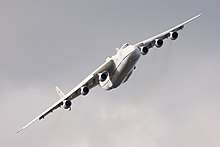
Ukraine produces nearly all types of transportation vehicles and spacecraft. Antonov airplanes and KrAZ trucks are exported to many countries. The majority of Ukrainian exports are marketed to the European Union and CIS.[275] Since independence, Ukraine has maintained its own space agency, the National Space Agency of Ukraine (NSAU). Ukraine became an active participant in scientific space exploration and remote sensing missions. Between 1991 and 2007, Ukraine has launched six self made satellites and 101 launch vehicles, and continues to design spacecraft.[276][277][278]
The country imports most energy supplies, especially oil and natural gas and, to a large extent, depends on Russia as its energy supplier. While 25% of the natural gas in Ukraine comes from internal sources, about 35% comes from Russia and the remaining 40% from Central Asia through transit routes that Russia controls. At the same time, 85% of the Russian gas is delivered to Western Europe through Ukraine.[279]

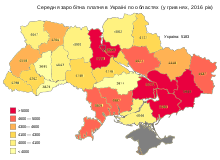
Growing sectors of the Ukrainian economy include the information technology (IT) market.[280] In 2013, Ukraine ranked fourth in the world in number of certified IT professionals after the United States, India and Russia.[281]
Ukraine's 2010 GDP, as calculated by the World Bank, was around $136 billion, 2011 GDP – around $163 billion, 2012 – $176.6 billion, 2013 – $177.4 billion.[282] In 2014 and 2015, the Ukrainian currency was the world's worst performing currency, having dropped 80 percent of its value since April 2014 since the War in Donbass and the annexation of Crimea by Russia.[283][284]
The World Bank classifies Ukraine as a middle-income state.[285] Significant issues include underdeveloped infrastructure and transportation, corruption and bureaucracy. The public will to fight against corrupt officials and business elites culminated in a strong wave of public demonstrations against the Victor Yanukovych's regime in November 2013.[286] According to Transparency International's Corruption Perceptions Index, Ukraine was ranked 120th with a score of 32 out of 100 in 2018.[287] In the first quarter of 2017, the level of shadow economy in Ukraine amounted to 37% of GDP.[288]
In the 2000s Ukraine managed to achieve certain progress in reducing absolute poverty, ensuring access to primary and secondary education, improving maternal health and reducing child mortality.[289]
The economy of Ukraine overcame the heavy crisis caused by armed conflict in southeast part of country. At the same time, 200% devaluation of Ukrainian hryvnia (national currency) in 2014–2015 made Ukrainian goods and services cheaper and more сompetitive.[290] In 2016, for the first time since 2010, the economy grew more than 2%. According to World Bank statement growth is projected at 2% in 2017 and 3.5% in 2018.
As of 2017, according to major economic classifications of countries such as gross domestic product (at purchasing power parity) or the Human Development Index, Ukraine is the second poorest country in Europe, after Moldova.[291][292] Ukraine has one of the most equal income distribution as measured by the Gini index and Palma ratio.[293]
Corporations
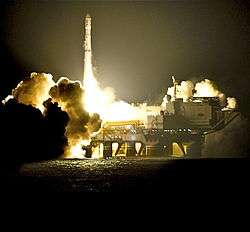
Ukraine has a very large heavy-industry base and is one of the largest refiners of metallurgical products in Eastern Europe.[294] However, the country is also well known for its production of high-technological goods and transport products, such as Antonov aircraft and various private and commercial vehicles.[295] The country's largest and most competitive firms are components of the PFTS index, traded on the PFTS Ukraine Stock Exchange.
Well-known Ukrainian brands include Naftogaz Ukrainy, AvtoZAZ, PrivatBank, Roshen, Yuzhmash, Nemiroff, Motor Sich, Khortytsa, Kyivstar and Aerosvit.[296]
Ukraine is regarded as a developing economy with high potential for future success, though such a development is thought likely only with new all-encompassing economic and legal reforms.[297] Although Foreign Direct Investment in Ukraine remained relatively strong since recession of the early 1990s, the country has had trouble maintaining stable economic growth. The reasons are the takeover and monopolisation of traditional heavy industries by wealthy individuals such as Rinat Akhmetov, the enduring failure to broaden the nation's economic base and a lack of effective legal protection for investors and their products.[298]
Transport
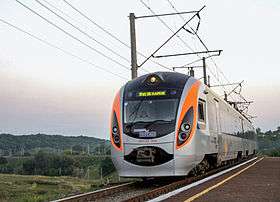
.jpg)
In total, Ukrainian paved roads stretch for 164,732 kilometres (102,360 mi).[41] Major routes, marked with the letter 'M' for 'International' (Ukrainian: Міжнародний), extend nationwide and connect all major cities of Ukraine, and provide cross-border routes to the country's neighbours. There are only two true motorway standard highways in Ukraine; a 175-kilometre (109-mile) stretch of motorway from Kharkiv to Dnipro and a section of the M03 which extends 18 km (11 mi) from Kiev to Boryspil, where the city's international airport is located.
Rail transport in Ukraine connects all major urban areas, port facilities and industrial centres with neighbouring countries. The heaviest concentration of railway track is the Donbas region of Ukraine. Although rail freight transport fell in the 1990s, Ukraine is still one of the world's highest rail users.[299] The total amount of railroad track in Ukraine extends for 22,473 kilometres (13,964 mi), of which 9,250 kilometres (5,750 mi) was electrified in the 2000s.[41] Currently the state has a monopoly on the provision of passenger rail transport, and all trains, other than those with cooperation of other foreign companies on international routes, are operated by its company 'Ukrzaliznytsia.
_Ukraine.jpg)
Transport by air is developing quickly, with a visa-free programme for EU nationals and citizens of a number of other Western nations,[300] the nation's aviation sector is handling a significantly increased number of travellers. The Euro 2012 football tournament, held in Poland and Ukraine as joint hosts, prompted the government to invest heavily in transport infrastructure, and in particular airports.[301] The Donetsk airport, completed for Euro 2012, was destroyed by the end of 2014 because of the ongoing war between the government and the separatist movement.[302]
Kiev Boryspil is the county's largest international airport; it has three main passenger terminals and is the base for the country's flag carrier, Ukraine International Airlines. Other large airports in the country include those in Kharkiv, Lviv and Donetsk (now destroyed), whilst those in Dnipro and Odessa have plans for terminal upgrades in the near future. In addition to its flag carrier, Ukraine has a number of airlines including Windrose Airlines, Dniproavia, Azur Air Ukraine, and AtlasGlobal Ukraine. Antonov Airlines, a subsidiary of the Antonov Aerospace Design Bureau is the only operator of the world's largest fixed wing aircraft, the An-225.
International maritime travel is mainly provided through the Port of Odessa, from where ferries sail regularly to Istanbul, Varna and Haifa. The largest ferry company presently operating these routes is Ukrferry.[303]
Energy
In 2014, Ukraine was ranked number 19 on the Emerging Market Energy Security Growth Prosperity Index, published by the think tank Bisignis Institute, which ranks emerging market countries using government corruption, GDP growth and oil reserve information.[304]
Ukraine produces and processes its own natural gas and petroleum. However, the majority of these commodities are imported. Eighty percent of Ukrainian natural gas supplies are imported, mainly from Russia.[305]
Natural gas is heavily utilised not only in energy production but also by steel and chemical industries of the country, as well as by the district heating sector. In 2012, Shell started exploration drilling for shale gas in Ukraine—a project aimed at the nation's total gas supply independence. Following the armed conflict in the Donbass, Ukraine was cut off from half of coal and all of its anthracite extraction, dropping Ukrainian coal production by 22 percent in 2014. Russia was Ukraine's largest coal supplier, and in 2014 Russia blocked its coal supplies, forcing 22 Ukrainian power plants to shut down temporarily.
Power generation
Ukraine has been a net energy exporting country, for example in 2011, 3.3% of electricity produced were exported,[306] but also one of Europe's largest energy consumers.[307] As of 2011, 47.6% of total electricity generation was from nuclear power[306] The largest nuclear power plant in Europe, the Zaporizhia Nuclear Power Plant, is located in Ukraine. Until the 2010s, all of Ukraine's nuclear fuel was coming from Russia. In 2008 Westinghouse Electric Company won a five-year contract selling nuclear fuel to three Ukrainian reactors starting in 2011.[308] Following Euromaidan then President Viktor Yanukovych introduced a ban on Rosatom nuclear fuel shipments to Europe via Ukraine, which was in effect from 28 January until 6 March 2014.[309] By 2016, Russia's share was down to 55 percent, Westinghouse supplying nuclear fuel for six of Ukraine's VVER-1000 nuclear reactors.[310] After the Russian annexation of Crimea in April 2014, the National Nuclear Energy Generating Company of Ukraine Energoatom and Westinghouse extended the contract for fuel deliveries through 2020.[311]
Coal and gas-fired thermal power stations and hydroelectricity are the second and third largest kinds of power generation in the country.
Renewable energy use
The share of renewables within the total energy mix is still very small, but is growing fast. Total installed capacity of renewable energy installations more than doubled in 2011 and as of 2012 stands at 397 MW.[312] In 2011 several large solar power stations were opened in Ukraine, among them Europe's largest solar park in Perovo, (Crimea).[313]
The Economic Bank for Reconstruction and Development estimateed in 2012 that Ukraine had great renewable energy potential: the technical potential for wind energy is estimated at 40 TWh/year, small hydropower stations at 8.3 TWh/year, biomass at 120 TWh/year, and solar energy at 50 TWh/year.[314]
Internet and IT
Ukraine has a large and steadily growing Internet sector, mostly uninfluenced by the financial crisis of 2007–08. As of June, 2014, there were 18.2 million desktop Internet users, which is 56% of the adult population. The core of the audience is the 25 to 34-year-old age bracket, representing 29% of the population.[315] Ukraine ranks 8th among the world's top ten countries with the fastest Internet access speed.[316]
According to A.T. Kearney Global Services Location Index,[317] Ukraine ranks 24th among the best outsourcing locations, and is among the top 20 offshore services locations in EMEA, according to Gartner.[318] In the first six months of 2017, the volume of export of computer and information services reached $1.256 billion, which is an 18.3% increase compared to the same period in 2016.[319] The IT industry ranks third in the export structure of Ukraine after agro-industry and metallurgy.
Ukraine's IT sector employs close to 100,000 workers, including 50,000 software developers. This number is expected to surpass the 200,000 mark by 2020.[320] There are over 1,000 IT companies in Ukraine.[321] In 2017, 13 of them made it to the list of 100 best outsourcing service providers in the world.[322] More than 100 multinational tech companies have R&D labs in Ukraine.[320]
Ukraine ranks first worldwide in the number of C++ and Unity3D developers, and second in the number of JavaScript, Scala, and Magento engineers.[323] 78% of Ukrainian tech workers report having an intermediate or higher level of English proficiency.[324]
Tourism
In 2007 Ukraine occupied 8th place in Europe by the number of tourists visiting, according to the World Tourism Organization rankings.[325] Ukraine has numerous tourist attractions: mountain ranges suitable for skiing, hiking and fishing: the Black Sea coastline as a popular summer destination; nature reserves of different ecosystems; churches, castle ruins and other architectural and park landmarks; various outdoor activity points. Kiev, Lviv, Odessa and Kamyanets-Podilskyi are Ukraine's principal tourist centres each offering many historical landmarks as well as formidable hospitality infrastructure. Tourism used to be the mainstay of Crimea's economy but there has been a major fall in visitor numbers following the Russian annexation in 2014.[326]
The Seven Wonders of Ukraine and Seven Natural Wonders of Ukraine are the selection of the most important landmarks of Ukraine, chosen by the general public through an Internet-based vote.
Demographics
.svg.png)
Population
Post World War II Ukraine's population gradually increased to a peak of 51.9 million in 1993. From 1993 to 2014, the last year the populations in Donbas and Crimea were included, population had decreased by 6.6 million, or 12.8%. The decline was caused by a reduction in birth rate, emigration, and a slight increase in death rate, largely attributed to poor living conditions and low-quality health care.[327][328]
Throughout the 19th and 20th centuries, millions of Ukrainians migrated to Canada, the United States, or other parts of the Russian Empire and the Soviet Union, creating a large Ukrainian diaspora. There are about 3 million Ukrainians living in Russia.[329][330]
Since about 2015 there has been a growing number of Ukrainians working in the European Union, particularly Poland. Eurostat reported that 662,000 Ukrainians received EU residence permits in 2017, with 585,439 being to Poland. World Bank statistics show that money remittances back to Ukraine have roughly doubled from 2015 to 2018, worth about 4% of GDP. It is unclear if those moving to work in the EU intend this to be temporary of permanent.[331][332] There are over 2 million Ukrainians working and living in Poland.[333][334]
The industrial regions in the east and southeast are the most heavily populated, and about 67.2% of the population lives in urban areas.[335]
Ethnic composition
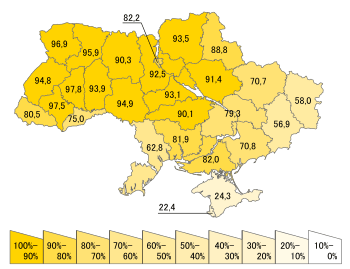
According to the Ukrainian Census of 2001, Ukrainians make up 77.8% of the population. Other significant ethnic groups include Russians (17.3%), Belarusians (0.6%), Moldovans (0.5%), Crimean Tatars (0.5%), Bulgarians (0.4%), Hungarians (0.3%), Romanians (0.3%), Poles (0.3%), Jews (0.3%), Armenians (0.2%), Greeks (0.2%) and Tatars (0.2%).[1] It is also estimated that there are about 50,000 ethnic Koreans (0.12%) in Ukraine that belong to the Koryo-saram group. Their number may be as high as 100,000, as many ethnic Koreans were assimilated into the majority population.[336][337]
Language
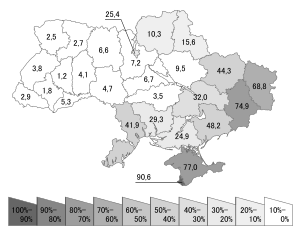
According to the constitution, the state language of Ukraine is Ukrainian.[338] Russian is widely spoken, especially in eastern and southern Ukraine.[338] According to the 2001 census, 67.5 percent of the population declared Ukrainian as their native language and 29.6 percent declared Russian.[339] Most native Ukrainian speakers know Russian as a second language.[338] Russian was the de facto official language of the Soviet Union but both Russian and Ukrainian were official languages in the Soviet Union[340] and in the schools of the Ukrainian SSR learning Ukrainian was mandatory.[338] Effective in August 2012, a new law on regional languages entitles any local language spoken by at least a 10 percent minority be declared official within that area.[341] Russian was within weeks declared as a regional language in several southern and eastern oblasts (provinces) and cities.[342] Russian can now be used in these cities'/oblasts' administrative office work and documents.[343][344] On 23 February 2014, following the 2014 Ukrainian revolution, the Ukrainian Parliament voted to repeal the law on regional languages, making Ukrainian the sole state language at all levels; however, the repeal was not signed by acting President Turchynov or by President Poroshenko.[345][346][347] In February 2019, the law allowing for regional languages was found unconstitutional.[348]
Ukrainian is mainly spoken in western and central Ukraine.[338] In western Ukraine, Ukrainian is also the dominant language in cities (such as Lviv). In central Ukraine, Ukrainian and Russian are both equally used in cities, with Russian being more common in Kiev,[f] while Ukrainian is the dominant language in rural communities. In eastern and southern Ukraine, Russian is primarily used in cities, and Ukrainian is used in rural areas. These details result in a significant difference across different survey results, as even a small restating of a question switches responses of a significant group of people.[f] Hungarian is spoken in the Zakarpattia Oblast.[349]
For a large part of the Soviet era, the number of Ukrainian speakers declined from generation to generation, and by the mid-1980s, the usage of the Ukrainian language in public life had decreased significantly.[350] Following independence, the government of Ukraine began restoring the image and usage of Ukrainian language through a policy of Ukrainisation.[351][352] Today, most foreign films and TV programs, including Russian ones, are subtitled or dubbed in Ukrainian.[353] Ukraine's 2017 education law bars primary education in public schools in grade five and up in any language but Ukrainian.[354][355] The Unian reported that "A ban on the use of cultural products, namely movies, books, songs, etc., in the Russian language in the public has been introduced" in the Lviv Oblast in September 2018.[356]
According to the Constitution of the Autonomous Republic of Crimea, Ukrainian is the only state language of the republic. However, the republic's constitution specifically recognises Russian as the language of the majority of its population and guarantees its usage 'in all spheres of public life'. Similarly, the Crimean Tatar language (the language of 12 percent of population of Crimea)[357] is guaranteed a special state protection as well as the 'languages of other ethnicities'. Russian speakers constitute an overwhelming majority of the Crimean population (77 percent), with Crimean Tatar speakers 11.4 percent and Ukrainian speakers comprising just 10.1 percent.[358] But in everyday life the majority of Crimean Tatars and Ukrainians in Crimea use Russian.[359]
Religion

A 2006 survey of the same Razumkov Centre, found that: 62.5% of all respondents were not religious, not believers or not affiliated to any religious body, 33.6% were Christians (26.8% Orthodox, 5.9% Catholics, and 0.9% Protestants), 0.1% were Jewish, and 3.8% were members of other religions.[361]
A 2016 survey conducted by the Razumkov Centre found that 70% of Ukrainians declared themselves believers in any religion, while 10.1% were uncertain whether they believed or not, 7.2% were uninterested in beliefs, 6.3% were unbelievers, 2.7% were atheists, and a further 3.9% found it difficult to answer the question.[362] The level of religiosity in Ukraine is greatest in Western Ukraine (91%), and lowest in Eastern Ukraine (56%) and the Donbass (57%).[362]
Of the Ukrainian population, 81.9% were Christians, comprising a 65.4% who declared to be Orthodox, 7.1% simply Christians, 6.5% Greek Rite Catholics, and 1.9% Protestants. A further 1.1% were Muslims and 1.0% Latin Rite Catholics. Judaism and Hinduism were the religions of 0.2% of the population each. A further 16.3% of the population did not identify in one of those listed hitherto.[363] According to the surveys conducted by Razumkov in the 2000s and early 2010s, such numbers have remained relatively constant throughout the last decade.[363]
Among those Ukrainians who declared to believe in Orthodoxy, 38.1% declared to be members of the Ukrainian Orthodox Church of the Kievan Patriarchate (a body that is not canonically recognized by the Eastern Orthodox Church), while 23.0% declared to be members of the Ukrainian Orthodox Church of the Moscovian Patriarchate (which is an autonomous Orthodox church under the Russian Orthodox Church). A further 2.7% were members of the Ukrainian Autocephalous Orthodox Church, which, like the Kievan Patriarchate, is not recognized by the Eastern Orthodox Church.[364] Among the remaining Orthodox Ukrainians, 32.3% declared to be "simply Orthodox", without affiliation to any patriarchate, while a further 3.1% declared that they "did not know" which patriarchate or Orthodox church they belonged to.[365] On 15 December 2018 the Ukrainian Orthodox Church – Kiev Patriarchate (UOC-KP) and the Ukrainian Autocephalous Orthodox Church (UAOC), and some members of the Ukrainian Orthodox Church (Moscow Patriarchate) (UOC-MP) united to form the Orthodox Church of Ukraine.[366] The Ecumenical Patriarch granted the status of autocephaly to the new Church the following month on 5 January 2019.[367] The Patriarch of Moscow retaliated by severing relations with Constantinople. The union of the Ukrainian Churches has not been recognized by other Orthodox Churches.
The second largest Christian group in Ukraine, Catholicism, is predominantly represented by the Ukrainian Greek Catholic Church, an Eastern Catholic Church in communion with the Holy See of the Roman Catholic Church. It recognizes the primacy of the Pope as head of the Church while still maintaining a similar liturgical and spiritual tradition as Eastern Orthodoxy.[368] Additionally, there are a small number of Latin Rite Catholic communities (1.0%).[363] The church consists mainly of ethnic Poles and Hungarians, who live predominantly in the western regions of the country. According to the 2018 survey, 'Religion in Ukraine,' by Razumkov the declared religion population is 9.4% Ukrainian Byzantine Rite Catholics and 0.8% Latin Rite Catholics.[363]
Protestants in Ukraine make up 1.9% of the population as of 2016.[363] Protestants had increased to 2.2% in the 2018 Razumkov Center survey. A further 7.1% of the population declares to be simply Christian.[363]
The Razumov Center surveys reported an increase of those who declared themselves Orthodox in 2018 at 67.3% up 1.9% from 2016 while declared Catholics rose from 7.5% to 10.6% in the same two-year period.
Health
The Ukrainian Red Cross Society was established in April 1918 in Kiev as an independent humanitarian society of the Ukrainian People's Republic. Its immediate tasks were to help refugees and prisoners of war, care for handicapped people and orphaned children, fight famine and epidemics, support and organize sick quarters, hospitals and public canteens. At present, society involves more than 6.3 million supporters and activists. Its Visiting Nurses Service has 3,200 qualified nurses. The organization takes part in more than 40 humanitarian programmes all over Ukraine, which are mostly funded by public donation and corporate partnerships. By its own estimates, the Society annually provides services to more than 105,000 lonely, elderly people, about 23,000 people disabled during the Second World War and handicapped workers, more than 25,000 war veterans, and more than 8,000 adults handicapped since childhood. Assistance for orphaned and disabled children is also rendered.
Ukraine's healthcare system is state subsidised and freely available to all Ukrainian citizens and registered residents. However, it is not compulsory to be treated in a state-run hospital as a number of private medical complexes do exist nationwide.[369] The public sector employs most healthcare professionals, with those working for private medical centres typically also retaining their state employment as they are mandated to provide care at public health facilities on a regular basis.
All of the country's medical service providers and hospitals are subordinate to the Ministry of Healthcare, which provides oversight and scrutiny of general medical practice as well as being responsible for the day-to-day administration of the healthcare system. Despite this, standards of hygiene and patient-care have fallen.[370]
Hospitals in Ukraine are organised along the same lines as most European nations, according to the regional administrative structure; as a result most towns have their own hospital (Міська Лікарня) and many also have district hospitals (Районна Лікарня). Larger and more specialised medical complexes tend only to be found in major cities, with some even more specialised units located only in the capital, Kiev. However, all oblasts have their own network of general hospitals which are able to deal with almost all medical problems and are typically equipped with major trauma centres; such hospitals are called 'regional hospitals' (Обласна Лікарня).
Ukraine currently faces a number of major public health issues and is considered to be in a demographic crisis because of its high death rate and low birth rate (the current Ukrainian birth rate is 11 births/1,000 population, and the death rate is 16.3 deaths/1,000 population). A factor contributing to the high death rate is a high mortality rate among working-age males from preventable causes such as alcohol poisoning and smoking.[371] In 2008, the country's population was one of the fastest declining in the world at −5% growth.[372][373] The UN warned that Ukraine's population could fall by as much as 10 million by 2050 if trends did not improve.[374] In addition, obesity, systemic high blood pressure and the HIV endemic are all major challenges facing the Ukrainian healthcare system.
As of March 2009 the Ukrainian government is reforming the health care system, by the creation of a national network of family doctors and improvements in the medical emergency services.[375] In November 2009, former Prime Minister Yulia Tymoshenko proposed introducing a public healthcare system based on health insurance in the spring of 2010.[376]
Active reformation of Ukraine's healthcare system was initiated right after the appointment of Ulana Suprun as a head of the Ministry of Healthcare.[377] Assisted by deputy Pavlo Kovtoniuk, Suprun first changed the distribution of finances in healthcare.[378] Funds must follow the patient. General practitioners will provide basic care for patients. The patient will have the right to choose one. Emergency medical service is considered to be fully funded by the state. Emergency Medicine Reform is also an important part of the healthcare reform. In addition, patients who suffer from chronic diseases, which cause a high toll of disability and mortality, are provided with free or low price medicine.[379]
Education
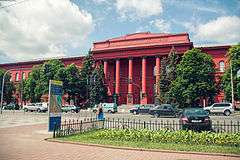
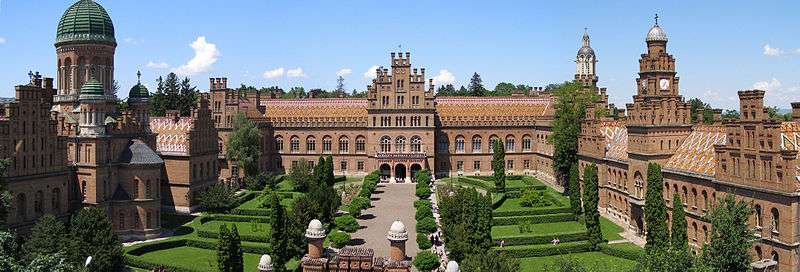
According to the Ukrainian constitution, access to free education is granted to all citizens. Complete general secondary education is compulsory in the state schools which constitute the overwhelming majority. Free higher education in state and communal educational establishments is provided on a competitive basis.[380] There is also a small number of accredited private secondary and higher education institutions.
Because of the Soviet Union's emphasis on total access of education for all citizens, which continues today, the literacy rate is an estimated 99.4%.[41] Since 2005, an eleven-year school programme has been replaced with a twelve-year one: primary education takes four years to complete (starting at age six), middle education (secondary) takes five years to complete; upper secondary then takes three years.[381] In the 12th grade, students take Government tests, which are also referred to as school-leaving exams. These tests are later used for university admissions.
The first higher education institutions (HEIs) emerged in Ukraine during the late 16th and early 17th centuries. The first Ukrainian higher education institution was the Ostrozka School, or Ostrozkiy Greek-Slavic-Latin Collegium, similar to Western European higher education institutions of the time. Established in 1576 in the town of Ostrog, the Collegium was the first higher education institution in the Eastern Slavic territories. The oldest university was the Kyiv Mohyla Academy, first established in 1632 and in 1694 officially recognised by the government of Imperial Russia as a higher education institution. Among the oldest is also the Lviv University, founded in 1661. More higher education institutions were set up in the 19th century, beginning with universities in Kharkiv (1805), Kiev (1834), Odessa (1865) and Chernivtsi (1875) and a number of professional higher education institutions, e.g.: Nizhyn Historical and Philological Institute (originally established as the Gymnasium of Higher Sciences in 1805), a Veterinary Institute (1873) and a Technological Institute (1885) in Kharkiv, a Polytechnic Institute in Kiev (1898) and a Higher Mining School (1899) in Katerynoslav. Rapid growth followed in the Soviet period. By 1988 a number of higher education institutions increased to 146 with over 850,000 students.[382] Most HEIs established after 1990 are those owned by private organisations.
The Ukrainian higher education system comprises higher educational establishments, scientific and methodological facilities under national, municipal and self-governing bodies in charge of education.[383] The organisation of higher education in Ukraine is built up in accordance with the structure of education of the world's higher developed countries, as is defined by UNESCO and the UN.[384] Ukraine has more than 800 higher education institutions and in 2010 the number of graduates reached 654,700 people.[385]
Ukraine produces the fourth largest number of post-secondary graduates in Europe, while being ranked seventh in population. Higher education is either state funded or private. Students that study at state expense receive a standard scholarship if their average marks at the end-of-term exams and differentiated test suffice; this rule may be different in some universities. For highest grades, the scholarship is increased by 25%. For most students the government subsidy is not sufficient to cover their basic living expenses. Most universities provide subsidised housing for out-of-city students. Also, it is common for libraries to supply required books for all registered students. Ukrainian universities confer two degrees: the bachelor's degree (4 years) and the master's degree (5–6th year), in accordance with the Bologna process. Historically, Specialist degree (usually 5 years) is still also granted; it was the only degree awarded by universities in the Soviet times.
The Law of Ukraine On Higher Education came into force on 6 September 2014. It was approved in Ukrainian Parliament on 1 July 2014. The main changes in the system of higher education:[386] a separate collegiate body to monitor the quality of education was established (Ukrainian: Національне агентство із забезпечення якості вищої освіти); each higher education institution has the right to implement its own educational and research programs; role of the student government was increased; higher education institution has the right to freely administer own revenues; 5 following types of higher education qualifications were established: Junior Bachelor, Bachelor, Master, Doctor of Philosophy (PhD) and Doctor of Science; load on lecturers and students was reduced; academic mobility for faculty and students etc.
Regional differences
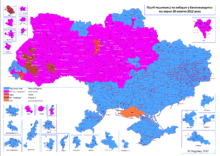
Ukrainian is the dominant language in Western Ukraine and in Central Ukraine, while Russian is the dominant language in the cities of Eastern Ukraine and Southern Ukraine. In the Ukrainian SSR schools, learning Russian was mandatory; currently in modern Ukraine, schools with Ukrainian as the language of instruction offer classes in Russian and in the other minority languages.[338][387][388][389]
On the Russian language, on Soviet Union and Ukrainian nationalism, opinion in Eastern Ukraine and Southern Ukraine tends to be the exact opposite of those in Western Ukraine; while opinions in Central Ukraine on these topics tend be less extreme.[388][390][391][392]
Similar historical cleavages also remain evident at the level of individual social identification. Attitudes toward the most important political issue, relations with Russia, differed strongly between Lviv, identifying more with Ukrainian nationalism and the Ukrainian Greek Catholic Church, and Donetsk, predominantly Russian orientated and favourable to the Soviet era, while in central and southern Ukraine, as well as Kiev, such divisions were less important and there was less antipathy toward people from other regions (a poll by the Research & Branding Group held March 2010 showed that the attitude of the citizens of Donetsk to the citizens of Lviv was 79% positive and that the attitude of the citizens of Lviv to the citizens of Donetsk was 88% positive).[393] However, all were united by an overarching Ukrainian identity based on shared economic difficulties, showing that other attitudes are determined more by culture and politics than by demographic differences.[393][394] Surveys of regional identities in Ukraine have shown that the feeling of belonging to a "Soviet identity" is strongest in the Donbas (about 40%) and the Crimea (about 30%).[395]
During elections voters of Western and Central Ukrainian oblasts (provinces) vote mostly for parties (Our Ukraine, Batkivshchyna)[396][397] and presidential candidates (Viktor Yuschenko, Yulia Tymoshenko) with a pro-Western and state reform platform, while voters in Southern and Eastern oblasts vote for parties (CPU, Party of Regions) and presidential candidates (Viktor Yanukovych) with a pro-Russian and status quo platform.[398][399][400][401] However, this geographical division is decreasing.[402][403][404]
Urbanisation
In total, Ukraine has 457 cities, 176 of them are labelled oblast-class, 279 smaller raion-class cities, and two special legal status cities. These are followed by 886 urban-type settlements and 28,552 villages.[405]
Culture
Ukrainian customs are heavily influenced by Orthodox Christianity, the dominant religion in the country.[364] Gender roles also tend to be more traditional, and grandparents play a greater role in bringing up children, than in the West.[406] The culture of Ukraine has also been influenced by its eastern and western neighbours, reflected in its architecture, music and art.[407]
The Communist era had quite a strong effect on the art and writing of Ukraine.[408] In 1932, Stalin made socialist realism state policy in the Soviet Union when he promulgated the decree "On the Reconstruction of Literary and Art Organisations". This greatly stifled creativity. During the 1980s glasnost (openness) was introduced and Soviet artists and writers again became free to express themselves as they wanted.[409]
The tradition of the Easter egg, known as pysanky, has long roots in Ukraine. These eggs were drawn on with wax to create a pattern; then, the dye was applied to give the eggs their pleasant colours, the dye did not affect the previously wax-coated parts of the egg. After the entire egg was dyed, the wax was removed leaving only the colourful pattern. This tradition is thousands of years old, and precedes the arrival of Christianity to Ukraine.[410] In the city of Kolomyia near the foothills of the Carpathian Mountains in 2000 was built the museum of Pysanka which won a nomination as the monument of modern Ukraine in 2007, part of the Seven Wonders of Ukraine action.
Weaving and embroidery
Artisan textile arts play an important role in Ukrainian culture,[411] especially in Ukrainian wedding traditions. Ukrainian embroidery, weaving and lace-making are used in traditional folk dress and in traditional celebrations. Ukrainian embroidery varies depending on the region of origin[412] and the designs have a long history of motifs, compositions, choice of colours and types of stitches.[413] Use of colour is very important and has roots in Ukrainian folklore. Embroidery motifs found in different parts of Ukraine are preserved in the Rushnyk Museum in Pereiaslav.
National dress is woven and highly decorated. Weaving with handmade looms is still practised in the village of Krupove, situated in Rivne Oblast. The village is the birthplace of two famous personalities in the scene of national crafts fabrication. Nina Myhailivna[414] and Uliana Petrivna[415] with international recognition. To preserve this traditional knowledge the village is planning to open a local weaving centre, a museum and weaving school.
Literature
The history of Ukrainian literature dates back to the 11th century, following the Christianisation of the Kievan Rus'.[416] The writings of the time were mainly liturgical and were written in Old Church Slavonic. Historical accounts of the time were referred to as chronicles, the most significant of which was the Primary Chronicle.[417][g] Literary activity faced a sudden decline during the Mongol invasion of Rus'.[416]
Ukrainian literature again began to develop in the 14th century, and was advanced significantly in the 16th century with the introduction of print and with the beginning of the Cossack era, under both Russian and Polish dominance.[416] The Cossacks established an independent society and popularized a new kind of epic poems, which marked a high point of Ukrainian oral literature.[417] These advances were then set back in the 17th and early 18th centuries, when publishing in the Ukrainian language was outlawed and prohibited. Nonetheless, by the late 18th century modern literary Ukrainian finally emerged.[416]
The 19th century initiated a vernacular period in Ukraine, led by Ivan Kotliarevsky's work Eneyida, the first publication written in modern Ukrainian. By the 1830s, Ukrainian romanticism began to develop, and the nation's most renowned cultural figure, romanticist poet-painter Taras Shevchenko emerged. Where Ivan Kotliarevsky is considered to be the father of literature in the Ukrainian vernacular; Shevchenko is the father of a national revival.[418]
Then, in 1863, use of the Ukrainian language in print was effectively prohibited by the Russian Empire.[67] This severely curtailed literary activity in the area, and Ukrainian writers were forced to either publish their works in Russian or release them in Austrian controlled Galicia. The ban was never officially lifted, but it became obsolete after the revolution and the Bolsheviks' coming to power.[417]
Ukrainian literature continued to flourish in the early Soviet years, when nearly all literary trends were approved (the most important literary figures of that time were Mykola Khvylovy, Valerian Pidmohylny, Mykola Kulish, Mykhayl Semenko and some others). These policies faced a steep decline in the 1930s, when prominent representatives as well as many others were killed by NKVD as part of the Great Purge. In general around 223 writers were repressed by what was known as the Executed Renaissance.[419] These repressions were part of Stalin's implemented policy of socialist realism. The doctrine did not necessarily repress the use of the Ukrainian language, but it required that writers follow a certain style in their works.
In post-Stalinist times literary activities continued to be somewhat limited under the Communist Party. The most famous figures of Ukrainian post-war Soviet literature were Lina Kostenko, Dmytro Pavlychko, Borys Oliynyk (poet), Ivan Drach, Oles Honchar, Vasyl Stus, Vasyl Symonenko.
Literary freedom grew in the late 1980s and early 1990s alongside the decline and collapse of the USSR and the reestablishment of Ukrainian independence in 1991.[416]
Architecture
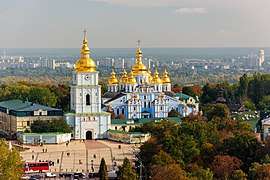
Ukrainian architecture includes the motifs and styles that are found in structures built in modern Ukraine, and by Ukrainians worldwide. These include initial roots which were established in the Eastern Slavic state of Kievan Rus'. Since the Christianization of Kievan Rus' for several ages Ukrainian architecture was influenced by the Byzantine architecture. After the 12th century, the distinct architectural history continued in the principalities of Galicia-Volhynia. During the epoch of the Zaporozhian Cossacks, a new style unique to Ukraine was developed under the western influences of the Polish–Lithuanian Commonwealth. After the union with the Tsardom of Russia, many structures in the larger eastern, Russian-ruled area were built in the styles of Russian architecture of that period, whilst the western Galicia was developed under Austro-Hungarian architectural influences. Ukrainian national motifs would finally be used during the period of the Soviet Union and in modern independent Ukraine.
The great churches of the Rus', built after the adoption of Christianity in 988, were the first examples of monumental architecture in the East Slavic lands. The architectural style of the Kievan state was strongly influenced by the Byzantine. Early Eastern Orthodox churches were mainly made of wood, with the simplest form of church becoming known as a cell church. Major cathedrals often featured scores of small domes, which led some art historians to take this as an indication of the appearance of pre-Christian pagan Slavic temples.

Several examples of these churches survive; however, during the 16th, 17th and 18th centuries, many were externally rebuilt in the Ukrainian Baroque style (see below). Examples include the grand St. Sophia of Kiev – the year 1017 is the earliest record of foundation laid, Church of the Saviour at Berestove – built from 1113 to 1125 and St. Cyril's Church, circa 12th-century. All can still be found in the Ukrainian capital. Several buildings were reconstructed during the late-19th century, including the Assumption Cathedral in Volodymyr-Volynskyi, built in 1160 and reconstructed in 1896–1900, the Paraskevi church in Chernihiv, built in 1201 with reconstruction done in the late 1940s, and the Golden gates in Kiev, built in 1037 and reconstructed in 1982. The latter's reconstruction was criticised by some art and architecture historians as a revivalist fantasy. Unfortunately little secular or vernacular architecture of Kievan Rus' has survived.
As Ukraine became increasingly integrated into the Russian Empire, Russian architects had the opportunity to realise their projects in the picturesque landscape that many Ukrainian cities and regions offered. St. Andrew's Church of Kiev (1747–1754), built by Bartolomeo Rastrelli, is a notable example of Baroque architecture, and its location on top of the Kievan mountain made it a recognisable monument of the city. An equally notable contribution of Rasetrelli was the Mariyinsky Palace, which was built to be a summer residence to Russian Empress Elizabeth. During the reign of the last Hetman of Ukraine, Kirill Razumovsky, many of the Cossack Hetmanate's towns such as Hlukhiv, Baturyn and Koselets had grandiose projects built by Andrey Kvasov. Russia eventually conquered the south of Ukraine and Crimea, and renamed them as New Russia. New cities such as Nikolayev, Odessa, Kherson and Sevastopol were founded. These would contain notable examples of Imperial Russian architecture.

In 1934, the capital of Soviet Ukraine moved from Kharkiv to Kiev. Previously, the city was seen as only a regional centre, hence received little attention. All of that was to change, at great price. The first examples of Stalinist architecture were already showing, and, in light of the official policy, a new city was to be built on top of the old one. This meant that much-admired examples such as the St. Michael's Golden-Domed Monastery were destroyed. Even the St. Sophia Cathedral was under threat. Also, the Second World War contributed to the wreckage. After the war, a new project for the reconstruction of central Kiev transformed Khreshchatyk avenue into a notable example of Stalinism in Architecture. However, by 1955, the new politics of architecture once again stopped the project from fully being realised.
The task for modern Ukrainian architecture is diverse application of modern aesthetics, the search for an architect's own artistic style and inclusion of the existing historico-cultural environment. An example of modern Ukrainian architecture is the reconstruction and renewal of the Maidan Nezalezhnosti in central Kiev. Despite the limit set by narrow space within the plaza, the engineers were able to blend together the uneven landscape, and use underground space for a new shopping centre.
A major project, which may take up most of the 21st century, is the construction of the Kiev City-Centre on the Rybalskyi Peninsula, which, when finished, will include a dense skyscraper park amid the picturesque landscape of the Dnieper.[421]
Music
.jpg)
Music is a major part of Ukrainian culture, with a long history and many influences. From traditional folk music, to classical and modern rock, Ukraine has produced several internationally recognised musicians including Kirill Karabits, Okean Elzy and Ruslana. Elements from traditional Ukrainian folk music made their way into Western music and even into modern jazz.
Ukrainian music sometimes presents a perplexing mix of exotic melismatic singing with chordal harmony. The most striking general characteristic of authentic ethnic Ukrainian folk music is the wide use of minor modes or keys which incorporate augmented 2nd intervals.
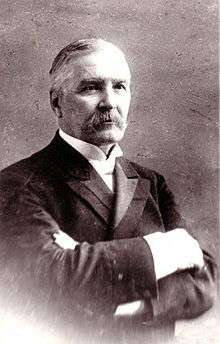
During the Baroque period, music was an important discipline for those that had received a higher education in Ukraine. It had a place of considerable importance in the curriculum of the Kyiv-Mohyla Academy. Much of the nobility was well versed in music with many Ukrainian Cossack leaders such as (Mazepa, Paliy, Holovatyj, Sirko) being accomplished players of the kobza, bandura or torban.
The first dedicated musical academy was set up in Hlukhiv, Ukraine in 1738 and students were taught to sing, play violin and bandura from manuscripts. As a result, many of the earliest composers and performers within the Russian empire were ethnically Ukrainian, having been born or educated in Hlukhiv, or had been closely associated with this music school. See: Dmytro Bortniansky, Maksym Berezovsky and Artemiy Vedel.
Ukrainian classical music falls into three distinct categories defined by whether the composer was of Ukrainian ethnicity living in Ukraine, a composer of non-Ukrainian ethnicity who was born or at some time was a citizen of Ukraine, or an ethnic Ukrainian living outside of Ukraine within the Ukrainian diaspora. The music of these three groups differs considerably, as do the audiences for whom they cater.
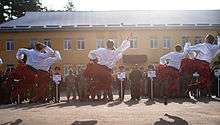
Since the mid-1960s, Western-influenced pop music has been growing in popularity in Ukraine. Folk singer and harmonium player Mariana Sadovska is prominent. Ukrainian pop and folk music arose with the international popularity of groups and performers like Vopli Vidoplyasova, Dakh Daughters, Dakha Brakha, Ivan Dorn and Okean Elzy.
Modern musical culture of Ukraine is presented both with academic and entertainment music. Ukraine has five conservatories, 6 opera houses, five houses of Chamber Music, Philharmony in all regional centers.
Ukraine hosted the Eurovision Song Contest 2005 and the Eurovision Song Contest 2017.
Cinema
Ukraine has had an influence on the history of the cinema. Ukrainian directors Alexander Dovzhenko, often cited as one of the most important early Soviet filmmakers, as well as being a pioneer of Soviet montage theory, Dovzhenko Film Studios, and Sergei Parajanov, Armenian film director and artist who made significant contributions to Ukrainian, Armenian and Georgian cinema. He invented his own cinematic style, Ukrainian poetic cinema, which was totally out of step with the guiding principles of socialist realism.
Other important directors including Kira Muratova, Sergei Loznitsa, Myroslav Slaboshpytskyi, Larisa Shepitko, Sergei Bondarchuk, Leonid Bykov, Yuri Ilyenko, Leonid Osyka, Ihor Podolchak with his Delirium and Maryna Vroda. Many Ukrainian actors have achieved international fame and critical success, including: Vera Kholodnaya, Bohdan Stupka, Milla Jovovich, Olga Kurylenko, Mila Kunis.
Despite a history of important and successful productions, the industry has often been characterised by a debate about its identity and the level of European and Russian influence. Ukrainian producers are active in international co-productions and Ukrainian actors, directors and crew feature regularly in Russian (Soviet in past) films. Also successful films have been based on Ukrainian people, stories or events, including Battleship Potemkin, Man with a Movie Camera, Winter on Fire: Ukraine's Fight for Freedom, Everything Is Illuminated.
Ukrainian State Film Agency owns National Oleksandr Dovzhenko Film Centre, film copying laboratory and archive, takes part in hosting of the Odessa International Film Festival, and Molodist is the only one FIAPF accredited International Film Festival held in Ukraine; competition program is devoted to student, first short and first full feature films from all over the world. Held annually in October.
Media
Ukrayinska Pravda[422] was founded by Georgiy Gongadze in April 2000 (the day of the Ukrainian constitutional referendum). Published mainly in Ukrainian with selected articles published in or translated to Russian and English, the newspaper has particular emphasis on the politics of Ukraine. Freedom of the press in Ukraine is considered to be among the freest of the post-Soviet states other than the Baltic states. Freedom House classifies the Internet in Ukraine as "free" and the press as "partly free". Press freedom has significantly improved since the Orange Revolution of 2004. However, in 2010 Freedom House perceived "negative trends in Ukraine".
Kiev dominates the media sector in Ukraine: the Kyiv Post is Ukraine's leading English-language newspaper. National newspapers Den, Mirror Weekly, tabloids, such as The Ukrainian Week or Focus (Russian), and television and radio are largely based there, although Lviv is also a significant national media centre. The National News Agency of Ukraine, Ukrinform was founded here in 1918. The Ukraine publishing sector, including books, directories and databases, journals, magazines and business media, newspapers and news agencies, has a combined turnover. Sanoma publishes Ukrainian editions of such magazines as Esquire, Harpers Bazaar and National Geographic Magazine. BBC Ukrainian started its broadcasts in 1992.
Ukrainians listen to radio programming, such as Radio Ukraine or Radio Liberty, largely commercial, on average just over two-and-a-half hours a day. Several television channels operate, and many websites are popular.
Sport

Ukraine greatly benefited from the Soviet emphasis on physical education. Such policies left Ukraine with hundreds of stadia, swimming pools, gymnasia and many other athletic facilities.[423] The most popular sport is football. The top professional league is the Vyscha Liha ("premier league").
Many Ukrainians also played for the Soviet national football team, most notably Ballon d'Or winners Ihor Belanov and Oleh Blokhin. This award was only presented to one Ukrainian after the dissolution of the Soviet Union, Andriy Shevchenko. The national team made its debut in the 2006 FIFA World Cup, and reached the quarterfinals before losing to eventual champions, Italy.
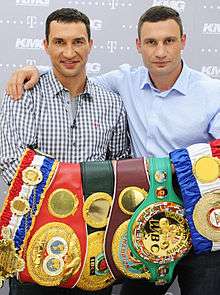
Ukrainian boxers are amongst the best in the world.[424] The brothers Vitali and Wladimir Klitschko are former heavyweight world champions who held multiple world titles throughout their careers. Also hailing from Ukraine, Vasyl Lomachenko, a 2008 and 2012 Olympic gold medalist. He is the current unified lightweight world champion who ties the record for winning a world title in the fewest professional fights; three. As of September 2018, he is ranked as the world's best active boxer, pound for pound, by ESPN,[425]
Sergey Bubka held the record in the Pole vault from 1993 to 2014; with great strength, speed and gymnastic abilities, he was voted the world's best athlete on several occasions.[426][427]
Basketball is becoming popular in Ukraine. In 2011, Ukraine was granted a right to organize EuroBasket 2015. Two years later the Ukraine national basketball team finished 6th in EuroBasket 2013 and qualified to FIBA World Cup for the first time in its history. Euroleague participant Budivelnyk Kyiv is the strongest professional basketball club in Ukraine.
Chess is a popular sport in Ukraine. Ruslan Ponomariov is the former world champion. There are about 85 Grandmasters and 198 International Masters in Ukraine.
Rugby league is played throughout Ukraine.[428]
Ukraine made its Olympic debut at the 1994 Winter Olympics. So far, Ukraine at the Olympics has been much more successful in Summer Olympics (115 medals in five appearances) than in the Winter Olympics. Ukraine is currently ranked 35th by number of gold medals won in the All-time Olympic Games medal count, with every country above it, except for Russia, having more appearances.
Cuisine
The traditional Ukrainian diet includes chicken, pork, beef, fish and mushrooms. Ukrainians also tend to eat a lot of potatoes, grains, fresh, boiled or pickled vegetables. Popular traditional dishes include varenyky (boiled dumplings with mushrooms, potatoes, sauerkraut, cottage cheese, cherries or berries), nalysnyky (pancakes with cottage cheese, poppy seeds, mushrooms, caviar or meat), kapuśniak (soup made with meat, potatoes, carrots, onions, cabbage, millet, tomato paste, spices and fresh herbs), borscht (soup made of beets, cabbage and mushrooms or meat), holubtsy (stuffed cabbage rolls filled with rice, carrots, onion and minced meat) and pierogi (dumplings filled with boiled potatoes and cheese or meat). Ukrainian specialties also include Chicken Kiev and Kiev cake. Ukrainians drink stewed fruit, juices, milk, buttermilk (they make cottage cheese from this), mineral water, tea and coffee, beer, wine and horilka.[429]
See also
Notes
a.^ Among the Ukrainians that rose to the highest offices in the Russian Empire were Aleksey Razumovsky, Alexander Bezborodko and Ivan Paskevich. Among the Ukrainians who greatly influenced the Russian Orthodox Church in this period were Stephen Yavorsky, Feofan Prokopovich and Dimitry of Rostov.
b.^ Estimates on the number of deaths vary. Official Soviet data is not available because the Soviet government denied the existence of the famine. See the Holodomor article for details. Sources differ on interpreting various statements from different branches of different governments as to whether they amount to the official recognition of the Famine as Genocide by the country. For example, after the statement issued by the Latvian Sejm on 13 March 2008, the total number of countries is given as 19 (according to Ukrainian BBC: "Латвія визнала Голодомор ґеноцидом"), 16 (according to Korrespondent, Russian edition: "После продолжительных дебатов Сейм Латвии признал Голодомор геноцидом украинцев"), "more than 10" (according to Korrespondent, Ukrainian edition: "Латвія визнала Голодомор 1932–33 рр. геноцидом українців") Retrieved 27 January 2008.
c.1 2 These figures are likely to be much higher, as they do not include Ukrainians of other nationalities or Ukrainian Jews, but only ethnic Ukrainians, from the Ukrainian SSR.
d.^ This figure excludes POW deaths.
e.^ Several countries with territory in Europe have a larger total area, but all of those also include territory outside of Europe. Only Russia's European territory is larger than Ukraine.
f.1 2 3 According to the official 2001 census data (by nationality;[430] by language[431]) about 75 percent of Kiev's population responded 'Ukrainian' to the native language (ridna mova) census question, and roughly 25 percent responded 'Russian'. On the other hand, when the question 'What language do you use in everyday life?' was asked in the 2003 sociological survey, the Kievans' answers were distributed as follows: 'mostly Russian': 52 percent, 'both Russian and Ukrainian in equal measure': 32 percent, 'mostly Ukrainian': 14 percent, 'exclusively Ukrainian': 4.3 percent.
"What language is spoken in Ukraine?". Welcome to Ukraine. February 2003. Retrieved 11 July 2008.
g.^ Such writings were also the base for Russian and Belarusian literature.
- Real estate not counted, but many Ukrainians possess real estate.
References
- "Population by ethnic nationality, 1 January, year". ukrcensus.gov.ua. Ukrainian Office of Statistics. Archived from the original on 17 December 2011. Retrieved 17 April 2010.
- Особливості Релігійного І Церковно-Релігійного Самовизначення Українських Громадян: Тенденції 2010-2018 [Features of Religious and Church - Religious Self-Determination of Ukrainian Citizens: Trends 2010-2018] (pdf) (in Ukrainian), Kiev: Razumkov Center in collaboration with the All-Ukrainian Council of Churches, 22 April 2018, pp. 12, 13, 16, 31, archived (PDF) from the original on 26 April 2018
Sample of 2,018 respondents aged 18 years and over, interviewed 23–28 March 2018 in all regions of Ukraine except Crimea and the occupied territories of the Donetsk and Lugansk regions. - "Population (by estimate) as of April 1, 2020. Average annual populations January-March 2020". ukrcensus.gov.ua. Retrieved 1 June 2020.
- "World Economic Outlook Database, October 2019". IMF.org. International Monetary Fund. Retrieved 16 May 2020.
- "GINI index (World Bank estimate) - Ukraine". data.worldbank.org. World Bank. Retrieved 22 March 2020.
- "Ukraine: Human Development Indicators 2019". United Nations Development Programme. 2019. Retrieved 25 December 2019.
- Рішення Ради: Україна 30 жовтня перейде на зимовий час [Rada Decision: Ukraine will change to winter time on 30 October] (in Ukrainian). korrespondent.net. 18 October 2011. Retrieved 31 October 2011.
- "The World Factbook – Ukraine". Central Intelligence Agency. 7 January 2014. Retrieved 23 January 2014.
- Simpson, John (19 March 2014). "Russia's Crimea plan detailed, secret and successful" – via bbc.com.
- "Ukraine – United Nations Statistics Division". United Nations. 2016. Retrieved 6 September 2016.
- "Population (by estimate) as of June 1, 2019. Average annual populations January-May 2019". ukrcensus.gov.ua. Retrieved 11 August 2019.
- "The "the" is gone". The Ukrainian Weekly. 8 December 1991. Retrieved 21 October 2015.
- "Declaration of State Sovereignty of Ukraine". Verkhovna Rada of Ukraine. Archived from the original on 27 September 2007. Retrieved 24 December 2007.
- "Ukraine - Trade - European Commission". ec.europa.eu.
- Anthony Shorrocks; Jim Davies; Rodrigo Lluberas (October 2018). Global Wealth Report. Credit Suisse. 10 October 2018 article: Global Wealth Report 2018: US and China in the lead. Report. Databook . Downloadable data sheets. See Table 3.1 (page 114) of databook for mean and median wealth by country
- "Next to Kyrgyzstan and Djibouti — Ukraine's Results in Corruption Perceptions Index 2019". Transparency International. 23 January 2020. Retrieved 18 February 2020.
- "Ukraine becomes world's third biggest grain exporter in 2011 – minister" (Press release). Black Sea Grain. 20 January 2012. Archived from the original on 31 December 2013. Retrieved 31 December 2013.
- "World Trade Report 2013". World Trade Organization. 2013. Retrieved 26 January 2014.
- "Ukraine Military Strength (2020)". Global Firepower. Retrieved 25 July 2020.
- "Linguistic divides: Johnson: Is there a single Ukraine?". The Economist. 5 February 2014. Retrieved 12 May 2014.
- Hryhoriy Pivtorak. Походження українців, росіян, білорусів та їхніх мов [The origin of Ukrainians, Russians, Belarusians and their languages] (in Ukrainian). Retrieved 21 October 2015.
- "Ukraine – Definition". Merriam-Webster Online Dictionary. Retrieved 4 May 2012.
- Adam Taylor (9 December 2013). "Why Ukraine Isn't 'The Ukraine,' And Why That Matters Now". Business Insider. Retrieved 21 October 2015.
- "'Ukraine' or 'the Ukraine'? It's more controversial than you think". Washington Post. 25 March 2014. Retrieved 11 August 2016.
- Geoghegan, Tom (7 June 2012), "Ukraine or the Ukraine: Why do some country names have 'the'?", BBC News Magazine, BBC
- Richard Gray (18 December 2011). "Neanderthals built homes with mammoth bones". Daily Telegraph. London. Retrieved 8 January 2014.
- K. Kris Hirst. "Molodova I and V (Ukraine)". About.
- "Mystery of the domestication of the horse solved: Competing theories reconciled". sciencedaily (sourced from the University of Cambridge). 7 May 2012. Retrieved 12 June 2014.
- Matossian Shaping World History p. 43
- "What We Theorize – When and Where Did Domestication Occur". International Museum of the Horse. Archived from the original on 23 July 2013. Retrieved 12 December 2010.
- "Horsey-aeology, Binary Black Holes, Tracking Red Tides, Fish Re-evolution, Walk Like a Man, Fact or Fiction". Quirks and Quarks Podcast with Bob Macdonald. CBC Radio. 7 March 2009. Archived from the original on 7 October 2014. Retrieved 18 September 2010.
- Sandrine Prat; Stéphane C. Péan; Laurent Crépin; Dorothée G. Drucker; Simon J. Puaud; Hélène Valladas; Martina Lázničková-Galetová; Johannes van der Plicht; Alexander Yanevich (17 June 2011). "The Oldest Anatomically Modern Humans from Far Southeast Europe: Direct Dating, Culture and Behavior". plosone. doi:10.1371/journal.pone.0020834.
- Jennifer Carpenter (20 June 2011). "Early human fossils unearthed in Ukraine". BBC. Retrieved 21 June 2011.
- "Scythian". Encyclopædia Britannica. Retrieved 21 October 2015.
- "Scythian: Ancient People". Online Britannica. 20 July 1998. Archived from the original on 27 March 2017. Retrieved 26 October 2017.
- "Khazar | Origin, History, Religion, & Facts". Encyclopedia Britannica.
- Magocsi, Paul Robert (16 July 1996). A History of Ukraine. University of Toronto Press. ISBN 9780802078209. Retrieved 16 July 2018 – via Google Books.
- Petro Tolochko. The Kievan Rus, establishment and development of the state nucleus (КИЇВСЬКА РУСЬ, СТАНОВЛЕННЯ ТА РОЗВИТОК ЯДРА ДЕРЖАВИ). Encyclopedia of History of Ukraine. 2007
- Belyayev, A. Rus and Varangians. Eurasian historical perspective (Русь и варяги. Евразийский исторический взгляд). Lev Gumilev Center. 13 September 2012
- A Geography of Russia and Its Neighbors ISBN 978-1-606-23920-9 p. 69
- "Ukraine". CIA World Factbook. 13 December 2007. Retrieved 24 December 2007.
- "Kievan Rus". The Columbia Encyclopedia (6 ed.). 2001–2007. Archived from the original on 19 August 2000. Retrieved 8 January 2014.
- FRANCIS BUTLER. Russian History. Brill. 1999
- The Dynasty of Chernigov, 1146–1246 ISBN 978-0-521-82442-2 pp. 117–118
- Power Politics in Kievan Rus': Vladimir Monomakh and His Dynasty, 1054-1246 ISBN 0-888-44202-5 pp. 195–196
- "The Destruction of Kiev". University of Toronto's Research Repository. Archived from the original on 27 April 2011. Retrieved 3 January 2008.
- "Roman Mstyslavych". encyclopediaofukraine.com.
- "Daniel Romanovich".Encyclopædia Britannica. 2007. Britannica Concise Encyclopedia. 23 August 2007
- Lemberg, Radio. "A HISTORY OF UKRAINE. EPISODE 33. THE CRIMEAN KHANATE AND ITS PERMANENT INVASIONS OF UKRAINE". radiolemberg.com.
- Subtelny, pp. 92–93
- "Poland". Encyclopædia Britannica (fee required). Archived from the original on 11 October 2007. Retrieved 12 September 2007.
- Brian Glyn Williams (2013). "The Sultan's Raiders: The Military Role of the Crimean Tatars in the Ottoman Empire" (PDF). The Jamestown Foundation. p. 16. Archived from the original (PDF) on 21 October 2013.
- Halil Inalcik. "Servile Labour in the Ottoman Empire" in A. Ascher, B. K. Kiraly, and T. Halasi-Kun (eds), The Mutual Effects of the Islamic and Judeo-Christian Worlds: The East European Pattern, Brooklyn College, 1979, pp. 25–43.
- Darjusz Kołodziejczyk, as reported by Mikhail Kizilov (2007). "Slaves, Money Lenders, and Prisoner Guards: The Jews and the Trade in Slaves and Captives in the Crimean Khanate". The Journal of Jewish Studies. p. 2.
- Subtelny, Orest (1988). "Ukraine: A History.". p 106
- Junius P. Rodriguez (1997). "The Historical encyclopedia of world slavery". ABC-CLIO. p. 659. ISBN 0-87436-885-5
- Mikhail Kizilov. "Slave Trade in the Early Modern Crimea From the Perspective of Christian, Muslim, and Jewish Sources". Oxford University.
- Krupnytsky B. and Zhukovsky A. "Zaporizhia, The". Encyclopedia of Ukraine. Retrieved 16 December 2007.
- "Ukraine – The Cossacks". Encyclopædia Britannica. Retrieved 21 October 2015.
- "The Crimean Tatars and their Russian-Captive Slaves Archived 5 June 2013 at the Wayback Machine" (PDF). Eizo Matsuki, Mediterranean Studies Group at Hitotsubashi University.
- "Poland – The Cossacks". Encyclopædia Britannica.
- Subtelny, pp. 123–124
- "300th anniversary of first Ukrainian constitution written by Pylyp Orlyk being celebrated", Kyiv Post, (5 April 2010)
- Reid (2000) p 27–30
- Skinner, Barbara (2005). "Borderlands of Faith: Reconsidering the Origins of a Ukrainian Tragedy". Slavic Review. 64 (1): 88–116. doi:10.2307/3650068. JSTOR 3650068.
- Ukraine under direct imperial Russian rule. Encyclopædia Britannica.
- Remy, Johannes (March–June 2007). "The Valuev Circular and Censorship of Ukrainian Publications in the Russian Empire (1863–1876): Intention and Practice". Canadian Slavonic Papers. 47 (1/2): 87–110. JSTOR 40871165.
- http://www.ditext.com/rudnytsky/history/first.html
- "Shevchenko, Taras". encyclopediaofukraine.com. Retrieved 1 November 2017.
- "Researching Crimea/Taurida". blackseagr.org. Retrieved 16 July 2018.
- Wolchik, Sharon (2000). Ukraine: The Search for a National Identity. Rowman & Littlefield. p. 5. ISBN 0847693465.
- Yekelchyk, Serhy (2015). The Conflict in Ukraine: What Everyone Needs to Know. Oxford University Press. p. 113. ISBN 978-0190237301.
- Rainer Münz, Rainer Ohliger (2003). "Diasporas and Ethnic Migrants: German, Israel, and Post-Soviet Successor States in Comparative Perspective". Routledge. p. 164. ISBN 0-7146-5232-6
- Subtelny, Orest (2000). "Ukraine: a history.". University of Toronto Press. p. 262. ISBN 0-8020-8390-0
- Jonathan D. Smele (2015). Historical Dictionary of the Russian Civil Wars, 1916–1926. Rowman & Littlefield. p.476. ISBN 1-4422-5281-2
- MAGOCSI, PAUL ROBERT (16 July 2018). The Roots of Ukrainian Nationalism: Galicia as Ukraine's Piedmont. University of Toronto Press. doi:10.3138/9781442682252. ISBN 9781442682252.
- Subtelny, Orest (2000). Ukraine: A History. University of Toronto Press. pp. 340–344. ISBN 978-0-8020-8390-6.
- Horbal, Bogdan. "Talerhof". The world academy of Rusyn culture. Archived from the original on 7 October 2007. Retrieved 20 January 2008.
- "The Hutsul Republic".
- Alexander Basilevsky (2016). Early Ukraine: A Military and Social History to the Mid–19th Century. McFarland. pp. 9–. ISBN 978-0-7864-9714-0.
- Cipko, Serge. "Makhno, Nestor". Encyclopedia of Ukraine. Retrieved 17 January 2008.
- "Interwar Soviet Ukraine". Encyclopædia Britannica (fee required). Archived from the original on 18 April 2008. Retrieved 12 September 2007.
- "Ukraine - World War I and the struggle for independence". Encyclopedia Britannica.
- Revyuk, Emil (8 July 1931). "Polish Atrocities in Ukraine". Svoboda Press – via Google Books.
- Skalmowski, Wojciech (8 July 2003). For East is East: Liber Amicorum Wojciech Skalmowski. Peeters Publishers. ISBN 9789042912984 – via Google Books.
- Radziejowski, Janusz; Studies, University of Alberta Canadian Institute of Ukrainian (8 July 1983). The Communist Party of Western Ukraine, 1919-1929. Canadian Institute of Ukrainian Studies, University of Alberta. ISBN 9780920862254 – via Google Books.
- "The Great Depression in Europe, 1929-39 | History Today". historytoday.com.
- "The Famine of 1920–1924". The Norka – a German Colony in Russia. Archived from the original on 9 March 2015. Retrieved 4 March 2015.
- "Famine of 1921–3". Encyclopedia of Ukraine. Retrieved 3 March 2015.
- Subtelny, p. 380
- "Communism". MSN Encarta. Archived from the original on 28 October 2009. Retrieved 5 July 2008.
- Cliff, pp. 138–139
- "Ukraine remembers famine horror". BBC News. 24 November 2007.
- Michael Ellman, "The Role of Leadership Perceptions and of Intent in the Soviet Famine of 1931–1934." Europe-Asia Studies 2005 57(6): 823–841. ISSN 0966-8136 Fulltext in Ebsco
- Stephen G. Wheatcroft, "Agency and Terror: Yevdokimov and Mass Killing in Stalin's Great Terror." Australian Journal of Politics and History 2007 53(1): 20–43. ISSN 0004-9522 Fulltext in Ebsco; Robert Conquest, The Harvest of Sorrow: Soviet collectivization and the terror-famine (1986). Mark B. Tauger, "The 1932 Harvest and the Famine of 1933" Slavic Review, Vol. 50, No. 1 (Spring, 1991), pp. 70–89, notes the harvest was unusually poor. online in JSTOR; R. W. Davies, Mark B. Tauger, S. G. Wheatcroft, "Stalin, Grain Stocks and the Famine of 1932–1933," Slavic Review, Vol. 54, No. 3 (Autumn, 1995), pp. 642–657 online in JSTOR; Michael Ellman. "Stalin and the Soviet famine of 1932–33 Revisited", Europe-Asia Studies, Volume 59, Issue 4 June 2007, pages 663–93.
- Yushchenko Praises Guilty Verdict Against Soviet Leaders For Famine, Radio Free Europe/Radio Liberty (14 January 2010)
- Wilson, p. 17
- Subtelny, p. 487
- Roberts, p. 102
- Boshyk, p. 89
- "World wars". Encyclopedia of Ukraine. Retrieved 20 December 2007.
- Subtelny, Orest (1988). "Ukraine: A History.". p 410
- Vedeneyev, D. Military Field Gendarmerie - special body of the Ukrainian Insurgent Army. "Voyenna Istoriya" magazine. 2002.
- Timothy Snyder. A fascist hero in democratic Kiev. NewYork Reviev of Books. 24 February 2010
- Grzegorz Motyka. Polska reakcja na działania UPA – skala i przebieg akcji odwetowych Archived 19 August 2014 at the Wayback Machine
- Piotrowski pp. 352–354
- Weiner pp. 127–237
- "Losses of the Ukrainian Nation, p. 2". Peremoga.gov.ua (in Ukrainian). Archived from the original on 15 May 2005. Retrieved 16 December 2007.
- Subtelny, p. 476
- Magocsi, p. 635
- "Ukrainian Insurgent Army". Encyclopedia of Ukraine. Retrieved 20 December 2007.
- "Ukraine – World War II and its aftermath". Encyclopædia Britannica. Archived from the original on 27 February 2010. Retrieved 28 December 2007.
- Karel Cornelis Berkhoff. Harvest of despair: life and death in Ukraine under Nazi rule, Harvard University Press: April 2004. p. 164
- Weinberg, p. 264
- Rozhnov, Konstantin, "Who won World War II?", BBC. Citing Russian historian Valentin Falin. Retrieved 5 July 2008.
- "Losses of the Ukrainian Nation, p. 1". Peremoga.gov.ua (in Ukrainian). Archived from the original on 25 October 2007. Retrieved 16 December 2007.
- Kulchytsky, Stalislav, "Demographic losses in Ukrainian in the twentieth century", Zerkalo Nedeli, 2–8 October 2004. Available online in Russian and in Ukrainian. Retrieved 27 January 2008.
- Smale, Alison (27 January 2014). "Shedding Light on a Vast Toll of Jews Killed Away From the Death Camps". The New York Times.
- "Losses of the Ukrainian Nation, p. 7". Peremoga.gov.ua (in Ukrainian). Archived from the original on 15 May 2005. Retrieved 16 December 2007.
- Overy, p. 518
- Кривошеев Г. Ф., Россия и СССР в войнах XX века: потери вооруженных сил. Статистическое исследование (Krivosheev G. F., Russia and the USSR in the wars of the 20th century: losses of the Armed Forces. A Statistical Study) (in Russian)
- "Holidays". Ministry of Foreign Affairs of Ukraine. Archived from the original on 20 April 2006. Retrieved 24 August 2008.
- "Ukraine: World War II and its aftermath". Encyclopædia Britannica (fee required). Archived from the original on 29 September 2007. Retrieved 12 September 2007.
- Кульчинский [Kulchytsky], Станислав [Stanislav] (2–8 October 2004), "Демографические потери Украины в XX веке" [Demographic losses in Ukraine in the twentieth century], Zerkalo Nedeli (in Russian), RU: [Demoscope], archived from the original on 14 September 2012
- "Демографические потери Украины в XX веке" [Demographic losses of Ukraine in the XX century] (in Russian). Zerkalo Nedeli. Archived from the original on 21 July 2006. Retrieved 8 January 2014.
- Демографічні втрати України в хх столітті [Demographic losses in Ukraine twentieth century] (in Ukrainian). Zerkalo Nedeli. Archived from the original on 13 March 2007. Retrieved 8 January 2014.
- "Activities of the Member States – Ukraine". United Nations. Retrieved 17 January 2011.
- "United Nations". U.S. Department of State. Retrieved 22 September 2014.
Voting procedures and the veto power of permanent members of the Security Council were finalized at the Yalta Conference in 1945 when Roosevelt and Stalin agreed that the veto would not prevent discussions by the Security Council. Roosevelt agreed to General Assembly membership for Ukraine and Byelorussia while reserving the right, which was never exercised, to seek two more votes for the United States.
- Malynovska, Olena (14 June 2006). "Migration and migration policy in Ukraine". Archived from the original on 23 September 2013.
- "The Transfer of Crimea to Ukraine". International Committee for Crimea. July 2005. Retrieved 25 March 2007.
- "Ukraine – The last years of Stalin's rule". Encyclopædia Britannica (fee required). Archived from the original on 15 January 2008. Retrieved 28 December 2007.
- Magocsi, p. 644
- Remy, Johannes (1996). "'Sombre anniversary' of worst nuclear disaster in history – Chernobyl: 10th anniversary". UN Chronicle. Find articles. Archived from the original on 28 June 2012. Retrieved 16 December 2007.
- "Fukushima, Chernobyl and the Nuclear Event Scale". Archived from the original on 14 October 2017.
- "Geographical location and extent of radioactive contamination". Chernobyl.info. Swiss Agency for Development and Cooperation. Archived from the original on 30 June 2007. Retrieved 8 January 2014.
- "IAEA Report". In Focus: Chernobyl. Retrieved 31 May 2008.
- "Declaration of State Sovereignty of Ukraine". Verkhovna Rada of Ukraine. 16 July 1990. Archived from the original on 27 September 2007. Retrieved 12 September 2007.
- "Verkhovna Rada of Ukraine Resolution On Declaration of Independence of Ukraine". Verkhovna Rada of Ukraine. 24 August 1991. Archived from the original on 30 September 2007. Retrieved 12 September 2007.
- "Soviet Leaders Recall 'Inevitable' Breakup Of Soviet Union". RadioFreeEurope. 8 December 2006. Retrieved 12 September 2007.
- Solodkov, A. (Период распада: последний декабрь Союза. 26 декабря 1991 года). RBC. 26 December 2016.
- Shen, p. 41
- "Ukrainian GDP (PPP)". World Economic Outlook Database, October 2007. International Monetary Fund (IMF). Retrieved 10 March 2008.
- "Can Ukraine Avert a Financial Meltdown?". World Bank. June 1998. Archived from the original on 12 July 2000. Retrieved 16 December 2007.
- Figliuoli, Lorenzo; Lissovolik, Bogdan (31 August 2002). "The IMF and Ukraine: What Really Happened". International Monetary Fund. Retrieved 16 December 2007.
- Aslund, Anders; Aslund, Anders (Autumn 1995). "Eurasia Letter: Ukraine's Turnaround". Foreign Policy. 100 (100): 125–143. doi:10.2307/1149308. JSTOR 1149308.
- "Macroeconomic Indicators". National Bank of Ukraine. Archived from the original on 21 October 2007.
- "Ukraine. Country profile" (PDF). World Bank. Archived from the original (PDF) on 7 June 2007. Retrieved 16 December 2007.
- Wines, Michael (1 April 2002). "Leader's Party Seems to Slip In Ukraine". The New York Times. Retrieved 24 December 2007.
- "Ukraine – Country Profiles – NTI". Retrieved 2 August 2014.
- "The Supreme Court findings" (in Ukrainian). Supreme Court of Ukraine. 3 December 2004. Retrieved 7 July 2008.
- "Yushchenko: 'Live And Carry On'". CBS News. 30 January 2005.
- "Associated Press: Study: Dioxin that poisoned Yushchenko made in lab".
- "Yushchenko to Russia: Hand over witnesses". Kyiv Post. 28 October 2009. Retrieved 11 February 2010.
- "Ukraine-Independent Ukraine". Encyclopædia Britannica (fee required). Archived from the original on 15 January 2008. Retrieved 14 January 2008.
- The Colour Revolutions in the Former Soviet Republics: Ukraine by Nathaniel Copsey, Routledge Contemporary Russia and Eastern Europe Series (page 30-44)
- US campaign behind the turmoil in Kiev, The Guardian (26 November 2004)
- Diuk, Nadia. "In Ukraine, Homegrown Freedom." Washington Post, 4 December 2004. URL Retrieved 12 September 2006
- Russia, the US, "the Others" and the "101 Things to Do to Win a (Colour)Revolution": Reflections on Georgia and Ukraine by Abel Polese, Routledge (26 October 2011)
- Ukraine comeback kid in new deal, BBC News (4 August 2006)
- Tymoshenko picked for Ukraine PM, BBC News (18 December 2007)
- Roman Olearchyk (31 July 2013). "Lacklustre GDP data push Ukraine towards fresh IMF bailout". Financial Times. Kiev. Retrieved 3 March 2014.
- Russia shuts off gas to Ukraine, BBC News (1 January 2009)
- Q&A: Russia-Ukraine gas row, BBC News (20 January 2009)
- Ukraine election: Yanukovych urges Tymoshenko to quit, BBC News (10 February 2010)In its final report on the election, the Organisation for Security and Cooperation in Europe said that the election "met most requirements" for fairness and that the election process was "transparent.""Ukraine: Presidential Election 17 January and 7 February 2010: OSCE/ODIHR Election Observation Mission Final Report" (PDF). OSCE. Warsaw. 28 April 2010. Retrieved 20 October 2015.
- "Q&A: Stand-off in Ukraine over EU agreement". BBC News. 17 December 2013. Archived from the original on 18 December 2013.
- Balmforth, Richard (11 December 2013). "Kiev protesters gather, EU dangles aid promise". Reuters. Retrieved 17 October 2018.
- Johnson, Juliet; Köstem, Seçkin (May 2016). "Frustrated Leadership: Russia's Economic Alternative to the West". Global Policy. 7 (2): 207–216. doi:10.1111/1758-5899.12301. hdl:11693/36455.
In fact, the Ukrainian crisis broke out in November 2013 when former President Viktor Yanukovych announced under Russian pressure that he would no longer pursue an EU Association Agreement
- "Ukraine Radicals Steer Violence as Nationalist Zeal Grows". Bloomberg News. 11 February 2014.
- Lina Kushch (3 December 2013). "Donetsk view: Ukraine 'other half' resents Kiev protests". BBC News.
- "A Ukraine City Spins Beyond the Government's Reach". The New York Times. 15 February 2014.
- Richard Balmforth (12 December 2013). "Kiev protesters gather, EU dangles aid promise". Reuters. Retrieved 20 October 2015.
- Независимое бюро новостей. "За добу в зіткненнях у Києві поранено 1,5 тисяч осіб, 100 зникли безвісти". nbnews.com.ua. Archived from the original on 25 February 2014.
- Інформація про постраждалих у сутичках: Прес-служба МОЗ України [Information about the victims of clashes: Press Service of the Ministry of Health of Ukraine] (in Ukrainian). moz.gov.ua. 22 February 2014. Archived from the original on 24 July 2014. Retrieved 25 September 2014.
- "МВС УКРАЇНИ". Міністерство внутрішніх справ України. Archived from the original on 24 September 2014. Retrieved 25 September 2014.
- ""список загиблих під час кривавих подій в Києві" — tsn.ua". ТСН.ua. 21 February 2014.
- Shaun Walker (27 January 2014). "Ukraine threatens state of emergency after protesters occupy justice ministry". The Guardian. Retrieved 12 May 2014.
- Krasnolutska, Daryna. "Ukraine clashes resume in Kiev as foreign mediation urged". Businessweek.com. Archived from the original on 6 July 2014. Retrieved 12 May 2014.
- "Opposition leaders sign deal with president to end crisis in Ukraine". Fox News Channel. 21 February 2014. Retrieved 19 November 2017.
- Keating, Dave (25 February 2014). "Ukraine sets date for presidential election". Europeanvoice.com. Retrieved 12 May 2014.
- The New York Times, "Dozens of Separatists Killed in Ukraine Army Attack", By SABRINA TAVERNISE and ANDREW ROTHMAY 27, 2014
- David M. Herszenhorn (24 May 2014). "Election of President Seen as a Beginning to Repairing Ukraine". NYT. Retrieved 12 January 2015.
- RTVi, News-script for Broadcast of 25 May 2014, Ekaterina Andreeff.
- Adam Taylor (28 January 2014). "Why Ukraine Is So Important". Business Insider. Archived from the original on 14 February 2014. Retrieved 29 May 2014.
- Lukas Alpert (29 May 2014). "Petro Poroshenko to Be Inaugurated as Ukraine President June 7". The Wall Street Journal. Archived from the original on 29 May 2014. Retrieved 29 May 2014.
- "Rada decides to hold inauguration of Poroshenko on June 7 at 1000". Interfax-Ukraine. 3 June 2014. Archived from the original on 3 June 2014. Retrieved 20 October 2015.
- David M. Herszenhorn (27 October 2014). "Ukrainian Voters Affirm Embrace of Europe and Reject Far Right; Arseniy Yatsenyuk and Petro Poroshenko Solidify Stances". The New York Times. Retrieved 16 April 2015.
- Ukrainian MPs vote to oust President Yanukovych bbc.co.uk, 22 February 2014, accessed 1 January 2016
- "Vladimir Putin describes secret meeting when Russia decided to seize Crimea". The Guardian. Agence France-Presse. 9 March 2015. Retrieved 20 October 2015.
- "Putin reveals the moment he gave the secret order for Russia's annexation of Crimea". telegraph.co.uk. 9 March 2015. Retrieved 20 October 2015.
- "Putin: Russia Prepared Raising Nuclear Readiness Over Crimea". New York Times. Associated Press. 15 March 2015. Archived from the original on 20 June 2015.
- Neil MacFarquhar (16 March 2015). "Putin Says He Weighed Nuclear Alert Over Crimea". nytimes.com. Retrieved 20 October 2015.
- Shaun Walker (9 March 2015). "Russians pressure Ukrainian forces in Crimea to disarm". The Guardian. Retrieved 20 October 2015.
- Olena Goncharova; Kyiv Post staff (16 March 2015). "A year after referendum, Putin talks about Yanukovych rescue, nuclear readiness over Crimea". kyivpost.com. Retrieved 20 October 2015.
- "Russian Roulette: The Invasion of Ukraine (Dispatch One)". vicenews.com. 5 March 2014. Retrieved 20 October 2015.
- "Official results: 97 percent of Crimea voters back joining Russia". cbsnews.com. 17 March 2014. Retrieved 20 October 2015.
- Alex Felton; Marie-Louise Gumuchian (27 March 2014). "U.N. General Assembly resolution calls Crimean referendum invalid". cnn.com. Retrieved 20 October 2015.
- "Донецькі сепаратисти готуються сформувати "народну облраду" та приєднатися до РФ". Українська правда. Retrieved 15 December 2017.
- "Russia Keeps Its Distance After Ukraine Secession Referendums". The New York Times. 12 May 2014.
- Anna Dolgov (21 November 2014). "Russia's Igor Strelkov: I Am Responsible for War in Eastern Ukraine". The Moscow Times. Retrieved 21 October 2015.
- Roman Olearchyk (7 August 2014). "Rebel leader quits Donetsk amid infighting". Financial Times. Retrieved 21 October 2015.
- Sabrian Tavernise; Noah Sneider (13 July 2014). "For a Weekend, Ukraine Rebels Make Love, Not War". New York Times. Retrieved 21 October 2015.
- Text of Joint Diplomatic Statement on Ukraine, 17 April 2014, The New York Times, retrieved 30 April 2014
- "Poroshenko promises calm 'in hours' amid battle to control Donetsk airport". The Guardian. 26 May 2014. Archived from the original on 26 May 2014. Retrieved 29 May 2014.
- Uri Friedman (26 August 2014). "A 24-Step Plan". The Atlantic. Retrieved 21 October 2015.
- Ukraine ratifies EU association agreement. Deutsche Welle. Published 16 September 2014.
- Richard Balmforth and Natalia Zinets. Ukraine president sets 2020 as EU target date, defends peace plan. Reuters. Published on 25 September 2014.
- Ian Traynor (13 February 2015). "Ukraine ceasefire: European leaders sceptical peace plan will work". The Guardian. Retrieved 18 June 2015.
- < EU-Ukraine Deep and Comprehensive Free Trade Area . trade.ec.europa.eu.
- "Ukrainians can now travel to EU Member States without a visa". 11 June 2017. Retrieved 17 February 2019.
- "Timeline of Ukraine's response to coronavirus outbreak". Kyiv Post. 19 March 2020.
- "National Bank cuts policy rate, continues forex sales". Kyiv Post. 13 March 2020.
- "Rada passes law on combating COVID-19". Interfax-Ukraine. 17 March 2020.
- "Ukrinform: Rada passes law on penalties for violating coronavirus quarantine". Kyiv Post. Ukrinform. 17 March 2020.
- "Ukraine shuts down public transportation, domestic travel, restaurants". Kyiv Post. 17 March 2020.
- "Order Tickets". Ukrzaliznytsia. 18 March 2020. Retrieved 21 March 2020.
- "Kyiv subway shutdown causes public transport chaos". Kyiv Post. 21 March 2020.
- "Зеленський попросив у МВФ більше грошей для України через коронавірус". Дзеркало тижня. Україна. 22 March 2020.
- "Ukraine opens borders with Moldova and EU, but not with Belarus and Russia". BELSAT. 29 May 2020.
- "Ukraine – Relief". Encyclopædia Britannica (fee required). Archived from the original on 15 January 2008. Retrieved 27 December 2007.
- Oksana Grytsenko (9 December 2011). "Environment suffers from lack of recycling". Kyiv Post. Archived from the original on 5 January 2012.
- "Ukraine". Encyclopædia Britannica.
- Magocsi, Paul R. A history of Ukraine: The land and its peoples. University of Toronto Press, 2010.
- "Ukraine". Country Pasture/Forage Resource Profiles. Food and Agriculture Organization. Retrieved 8 August 2016.
- "Ukraine – Climate". Encyclopædia Britannica. Retrieved 20 October 2015.
- D.W. Minter and Dudka, I.O. "Fungi of Ukraine – a preliminary checklist". CAB International, 1996
- "Cybertruffle's Robigalia – Observations of fungi and their associated organisms". cybertruffle.org.uk. Retrieved 13 July 2011.
- Kirk, P.M., Cannon, P.F., Minter, D.W. and Stalpers, J. "Dictionary of the Fungi". Edn 10. CABI, 2008
- "Fungi of Ukraine – potential endemics". cybertruffle.org.uk. Retrieved 13 July 2011.
- Paul J. D'Anieri (2007). Understanding Ukrainian Politics: Power, Politics, and Institutional Design. M.E. Sharpe. p. 63. ISBN 978-0-7656-1811-5.
- EU endorses Ukraine election result, euobserver (8 February 2010)
- International observers say Ukrainian election was free and fair, Washington Post (9 February 2010)
- European Parliament president greets Ukraine on conducting free and fair presidential election, Kyiv Post (9 February 2010)
- Віталій Портников. "Vitaly Portnykov. "Comment on the Constitutional Court of Ukraine on elimination of political reform in 2004 for Radio Liberty asked Nicholas Onischuk, former Justice Minister ... 25 February 2008 the Constitutional Court came to the conclusion that this bill can not be subject to constitutional control, but now we see that the Constitutional Court concluded that it can". 1 October 2010". Radiosvoboda.org. Retrieved 31 October 2011.
- "Yulia Tymoshenko: October 1 marks the end of Ukraine's democracy and beginning of dictatorship". Tymoshenko.ua. 1 October 2010. Archived from the original on 9 October 2011. Retrieved 31 October 2011.
- Hrabovsky, Serhiy (1 October 2010). Судові абсурди, або Котляревський знову сміється [Judicial absurdities, or Kotliarevsky is laughing again] (in Ukrainian). radiosvoboda.org. Retrieved 6 April 2016.
(Translation) These words handed down on the decision of the Constitutional Court of Ukraine (CCU) regarding cancelling the political reforms of 2004 are worthy of being inscribed in the annals of world jurisprudence. It turns out that "the stability of the constitutional order" will not be changed by the will of the voters, or even by Parliament, but by the decision of 18 persons.
- "President Yanukovych and Ukraine opposition sign early poll deal". europesun.com. 21 February 2014. Archived from the original on 28 February 2014.
- "Ukraine: Speaker Oleksandr Turchynov named interim president". BBC News. Kiev. 23 February 2014. Retrieved 6 April 2016.
- Salem, Harriet (4 March 2014). "Who exactly is governing Ukraine?". The Guardian. Retrieved 6 April 2016.
- "General Articles about Ukraine". Government Portal. Archived from the original on 20 January 2008. Retrieved 24 December 2007.
- "Verkhovna Rada of Ukraine". Verkhovna Rada of Ukraine Official Web-site. Archived from the original on 23 December 2007. Retrieved 24 December 2007.
- "Constitution of Ukraine". Wikisource. Retrieved 24 December 2007.
- "WJP Rule of Law Index® 2018-2019". data.worldjusticeproject.org.
- Prosecutors fail to solve biggest criminal cases, Kyiv Post (25 March 2010)
- (in Ukrainian) Українські суди майже не виносять виправдувальних вироків Ukrainian courts almost can not stand the acquittals, Ukrayinska Pravda (8 March 2013)
- Moskal: 'Rotten to the core', Kyiv Post (25 March 2010)
- Jackpot, Kyiv Post, 25 March 2010
- "Constitutional Court rules Russian, other languages can be used in Ukrainian courts". Kyiv Post. 15 December 2011.
(in Ukrainian) "З подачі "Регіонів" Рада дозволила російську у судах". Ukrayinska Pravda. 23 June 2009.
- "Російська мова стала офіційною в українських судах". for-ua.com.
- Chivers, C. J. (17 January 2005). "How Top Spies in Ukraine Changed the Nation's Path". Retrieved 15 June 2018.
- Ukraine has no alternative to Euro-Atlantic integration – Ukraine has no alternative to Euro-Atlantic integration – Poroshenko, Interfax-Ukraine (23 December 2014)
Ukraine abolishes its non-aligned status – law, Interfax-Ukraine (23 December 2014)
Ukraine's complicated path to NATO membership, Euronews (23 December 2014)
Ukraine Takes Step Toward Joining NATO, New York Times (23 December 2014)
https://www.wsj.com/articles/ukraine-ends-nonaligned-status-earning-quick-rebuke-from-russia-1419339226 Ukraine Ends 'Nonaligned' Status, Earning Quick Rebuke From Russia, The Wall Street journal (23 December 2014) - "Teixeira: Ukraine's EU integration suspended, association agreement unlikely to be signed". Interfax. 31 August 2012. Retrieved 6 September 2012.
- "EU, Ukraine to sign remaining part of Association Agreement on June 27 – European Council". Retrieved 25 June 2016.
- "'History wars' strain Ukraine-Poland relations again". The Irish Times. 3 November 2017.
- "Hungary threatens Ukraine's EU ties over new education law". Deutsche Welle. 13 October 2018.
- https://eeas.europa.eu/sites/eeas/files/tradoc_150981.pdf
- http://eeas.europa.eu/archives/delegations/ukraine/documents/virtual_library/vademecum_en.pdf
- Claudia Patricolo. Ukraine looks to revive V4 membership hopes as Slovakia takes over presidency. emerging-europe.com. 29 July 2018.
- "The council reduced the number of districts in Ukraine: 136 instead of 490". Ukrainska Pravda (in Ukrainian). 17 July 2020.
- "The history of the Armed Forces of Ukraine". Ministry of Defence of Ukraine. Retrieved 5 July 2008.
- "Ukraine Special Weapons". GlobalSecurity.org. Retrieved 24 December 2007.
- "White Book 2006" (PDF). Ministry of Defence of Ukraine. Archived from the original (PDF) on 8 November 2007. Retrieved 24 December 2007.
- "Ukrainian Navy Warship Hetman Sagaidachniy Joins EU Naval Force Counter Piracy Operation Atalanta". Eunavfor.eu. 6 January 2014. Retrieved 26 January 2014.
- "Multinational Peacekeeping Forces in Kosovo, KFOR". Ministry of Defence of Ukraine. Retrieved 24 December 2007.
- "Peacekeeping". Ministry of Defence of Ukraine. Retrieved 2 May 2008.
- "Kyiv Post. Independence. Community. Trust - Politics - Parliament approves admission of military units of foreign states to Ukraine for exercises". 22 May 2010. Archived from the original on 22 May 2010.
- "Child poverty soars in eastern Europe". BBC News. 11 October 2000. Retrieved 26 January 2014.
- "Independent Ukraine". Encyclopædia Britannica. Archived from the original on 18 April 2008. Retrieved 12 September 2007.
- Skolotiany, Yuriy (8 September 2006). "The past and the future of Ukrainian national currency". Zerkalo nedeli. Archived from the original on 25 June 2008. Retrieved 8 January 2014.
- "Ukraine". The World Factbook (2002 ed.). CIA. Retrieved 5 July 2008.
- "Ukraine – gdp". Index Mundi. Retrieved 15 July 2012.
- "CIA World Factbook – Ukraine. 2004 edition". CIA. Retrieved 5 July 2008.
- "Head of IMF's Resident Representative Office in Ukraine to change his job". Interfax-Ukraine. Retrieved 17 December 2008.
- "Average Wage Income in 2008 by Region". State Statistics Committee of Ukraine. Archived from the original on 29 May 2012. Retrieved 5 July 2008.
- "Ukraine's Other War: The Battle Against Systemic Corruption". Stratfor. 31 May 2018.
- "Structure export and import, 2006". State Statistics Committee of Ukraine. Archived from the original on 28 June 2012. Retrieved 5 July 2008.
- "Statistics of Launches of Ukrainian LV". National Space Agency of Ukraine. Retrieved 24 December 2007.
- "Missile defence, NATO: Ukraine's tough call". Business Ukraine. Archived from the original on 21 November 2008. Retrieved 5 July 2008.
- "Ukraine Special Weapons". The Nuclear Information Project. Retrieved 5 July 2008.
- Pirani, Simon (June 2007). "Ukraine's Gas Sector" (PDF). Oxford Institute for Energy Studies. p. 36. Retrieved 8 January 2014.
- Ballmer, Steve (20 May 2008). "Microsoft CEO Steve Ballmer Visits Ukraine". Microsoft. Archived from the original on 4 January 2009. Retrieved 28 July 2008.
- (in Ukrainian) Україна – четверта в світі за кількістю ІТ-фахівців Ukraine in fourth place in the world in the number of IT professionals, UNIAN (27 March 2013)
- "GDP (current US$) | Data". data.worldbank.org.
- Olearchyk, Roman (4 March 2015). "Ukraine sharply raises interest rates to 30 per cent". Financial Times. Retrieved 4 March 2015.
- "Ukraine raises interest rates to 30%". BBC News. 3 March 2015. Retrieved 9 March 2015.
- "What are Middle-Income Countries?". The World Bank Group. Retrieved 8 January 2014.
- "Business Corruption in Ukraine". Business Anti-Corruption Portal. Archived from the original on 25 March 2014. Retrieved 25 March 2014.
- "Corruption Perceptions Index 2018 Executive Summary" (PDF). transparency.org. Transparency International. 2018. p. 3. Retrieved 29 September 2019.
- "Economy ministry: Shadow economy in Ukraine drops to 37% of GDP in Q1". Unian. 22 September 2017.
- "About us". UNDP.
- Thor, Anatoliy. "The economy of Ukraine".
- "Human Development Report 2016" (PDF). United Nations Development Programme. Retrieved 8 March 2018.
- "Report for Selected Countries and Subjects". imf.org.
- Barr, Caelainn (26 April 2017). "Inequality index: where are the world's most unequal countries?". The Guardian. ISSN 0261-3077. Retrieved 26 April 2017.
- "Industry of Ukraine". Usndt.com.ua. Archived from the original on 31 December 2010. Retrieved 30 December 2010.
- "Ilyushin Finance to buy 10 An-158 planes from Ukraine's Antonov". RIA Novosti. 20 July 2010. Retrieved 30 December 2010.
- "Brand "Ukraine" will be reloaded in 2012". Ukraineanalysis.wordpress.com. 1 May 2008. Retrieved 26 January 2014.
- Michael Derrer (2004). "Growth Potential of the Ukrainian Economy: Is the "Miracle" Meant to Last?" (PDF). Archived from the original (PDF) on 25 July 2013. Retrieved 18 October 2014.
- "U.S. embassy: Ukraine could again be put on list of copyright violators". Kyiv Post. Interfax-Ukraine. 10 November 2010. Archived from the original on 14 November 2010. Retrieved 30 December 2010.
- "Transportation in Ukraine". U.S. Government Printing Office. Retrieved 22 December 2007.
- "Consulate General of Ukraine". Ukrconsul.org. Archived from the original on 1 December 2010. Retrieved 30 December 2010.
- "Kharkiv airport gets new terminal on". UEFA. 28 August 2010. Retrieved 30 December 2010.
- Alan Taylor (26 February 2015). "A Year of War Completely Destroyed the Donetsk Airport". The Atlantic. Retrieved 18 June 2015.
- "Судоходная компания Укрферри. Морские паромные перевозки на Черном Море между Украиной, Грузией, Турцией и Болгарией". Ukrferry.com. Retrieved 30 December 2010.
- "Bisignis Institute releases new country profiles for Azerbaijan and Ukraine" (Press release). Bisignis Institute. 6 January 2014. Archived from the original on 9 January 2014. Retrieved 8 January 2014.
- Axel Siedenberg; Lutz Hoffmann (1999). Ukraine at the Crossroads: Economic Reforms in International Perspective. Springer Science & Business Media. p. 393. ISBN 978-3-7908-1189-6.
- "Міністерство енергетики та вугільної промисловості України :: Інформаційна довідка про основні показники розвитку галузей паливно-енергетичного комплексу України за грудень та 2011 рік". mpe.kmu.gov.ua.
- "Ukraine". Energy Information Administration (EIA). US government. Archived from the original on 19 March 2014. Retrieved 22 December 2007.
- "Westinghouse Wins Contract to Provide Fuel Supplies to Ukraine". 30 March 2008. Westinghouse Electric. Archived from the original (press release) on 19 June 2015. Retrieved 15 April 2014.
- "Russia says restarts nuclear fuel transit to Europe via Ukraine". Reuters. 8 March 2014. Retrieved 15 April 2014.
- Peterson, Nolan (10 November 2017). "American coal miners undermine Putin's energy weapon against Ukraine". newsweek.com. Newsweek Media Group. Archived from the original on 10 November 2017. Retrieved 11 November 2017.
- "Westinghouse and Ukraine's Energoatom Extend Long-term Nuclear Fuel Contract". 11 April 2014. Westinghouse. Archived from the original on 11 April 2014. Retrieved 15 April 2014.
- "Відновлювана енергетика України стрімко зростає, але досі має мізерну частку | Зелена Хвиля". Ecoclubua.com. 29 July 2012. Retrieved 25 August 2012.
- Roca, Marc (29 December 2011). "Europe's Biggest Solar Park Completed With Russian Bank Debt". Bloomberg.
- Rachkevych, Mark (2 February 2012). "Ukraine only starting to harness potential of renewable energy". Kyiv Post. Archived from the original on 9 May 2012. Retrieved 8 January 2014.
- "Главные факты и цифры о digital-рынке Украины". Retrieved 20 August 2015.
- "Pando Networks Releases Global Internet Speed Study". Pandonetworks.com. 22 September 2011. Archived from the original on 3 December 2012. Retrieved 26 January 2014.
- "A.T. Kearney 2017 Global Services Location Index Spotlights Automation as Massive Job Displacer, Markets Insider". markets.businessinsider.com. Retrieved 7 October 2017.
- Marriott, Ian; Tramacere, Gianluca; Matson, Susanne. "Leading Offshore Services Locations in EMEA, 2015: Nearshore Increases Despite Geopolitical Concerns". gartner.com. Retrieved 8 October 2017.
- "IT industry ranked third in the export structure of Ukraine". eba.com.ua (in Ukrainian). Archived from the original on 11 October 2017. Retrieved 7 October 2017.
- Maznyuk, Victor; Sergiychuk, Inna. "Exploring Ukraine, IT Outsourcing Industry" (PDF). hi-tech.org.ua. Ukrainian Hi-Tech Initiative. Retrieved 9 October 2017.
- "Ukraine, ITOnews.eu". itonews.eu. Retrieved 9 October 2017.
- "IAOP : The 2017 Global Outsourcing 100". iaop.org. Retrieved 9 October 2017.
- "Ukrainian Developers: The Number of C++, Java, PHP, .NET Developers". daxx.com. Retrieved 10 October 2017.
- "Портрет ИТ-специалиста — 2017. Инфографика DOU". dou.ua (in Russian). Retrieved 10 October 2017.
- UNWTO World Tourism Barometer, volume 6, UNWTO (June 2008)
- Tourism takes a nosedive in Crimea bbc.co.uk, accessed 29 December 2015
- Peterson, Nolan (26 February 2017). "Why Is Ukraine's Population Shrinking?". Newsweek. Retrieved 9 July 2019.
- "Population". State Statistics Service of Ukraine. Retrieved 9 July 2019.
- "For Kremlin, Ukrainian election a choice between lesser of three evils". Reuters. 7 March 2019.
- "Russia and Ukraine Fight, But Their People Seek Reconciliation". The Moscow Times. 3 April 2019.
- Bershidsky, Leonid (20 February 2019). "Eastern Europe Feeds on a Shrinking Ukraine". Bloomberg. Retrieved 24 June 2019.
- Kiryukhin, Denys (14 May 2019). "Losing Brains and Brawn: Outmigration from Ukraine". Woodrow Wilson International Center for Scholars. Retrieved 24 June 2019.
- Santora, Marc (26 March 2019). "Poland Bashes Immigrants, but Quietly Takes Christian Ones". The New York Times.
- Walker, Shaun (18 April 2019). "'A whole generation has gone': Ukrainians seek a better life in Poland". The Guardian.
- "Ukraine – Statistics". United Nations Children's Fund (UNICEF). Retrieved 7 January 2008.
- "Державна служба статистики України". ukrstat.gov.ua. Retrieved 15 April 2019.
- "Phantom Syndrome: Ethnic Koreans in Ukraine". Bird In Flight. 18 July 2017. Retrieved 15 April 2019.
- Serhy Yekelchyk Ukraine: Birth of a Modern Nation, Oxford University Press (2007), ISBN 978-0-19-530546-3
- "Linguistic composition of the population". All-Ukrainian population census, 2001. Archived from the original on 1 November 2004. Retrieved 27 January 2008.
- L.A. Grenoble (2003). Language Policy in the Soviet Union. Springer Science & Business Media. p. 1. ISBN 978-1-4020-1298-3.
- "Yanukovych signs language bill into law". Kyivpost.com. 8 August 2012. Retrieved 26 January 2014.
- "Russian spreads like wildfires in dry Ukrainian forest". Kyivpost.com. 23 August 2012. Retrieved 26 January 2014.
- "Romanian becomes regional language in Bila Tserkva in Zakarpattia region". Kyiv Post. Interfax-Ukraine. 24 September 2012. Retrieved 20 October 2015.
- Michael Schwirtz (5 July 2012). "Ukraine". The New York Times.
- Проект Закону про визнання таким, що втратив чинність, Закону України "Про засади державної мовної політики" [Draft Law on the recognition of the void Law of Ukraine "On the basic principles of State Language Policy"] (in Ukrainian). Ukrainian Parliament. Retrieved 12 March 2015.
- Ian Traynor (24 February 2014). "Western nations scramble to contain fallout from Ukraine crisis". The Guardian.
- Andrew Kramer (2 March 2014). "Ukraine Turns to Its Oligarchs for Political Help". New York Times. Retrieved 2 March 2014.
- "Constitutional Court Declares Law On Language Policy Unconstitutional". ukranews.com. 28 February 2018.
- "Hungary plays ethnic card in all neighboring countries: experts explain "language row" with Ukraine". Unian. 7 December 2017.
- Shamshur, p. 159–168
- "Світова преса про вибори в Україні-2004 (Ukrainian Elections-2004 as mirrored in the World Press)". Архіви України (National Archives of Ukraine). Archived from the original on 8 January 2009. Retrieved 7 January 2008.
- "Criticism of Ukraine's language law justified: rights body". Reuters. 7 December 2017.
- "New language law could kill independent media ahead of 2019 elections". Kyiv Post. 19 October 2018.
- "Ukrainian Language Bill Facing Barrage Of Criticism From Minorities, Foreign Capitals". Radio Free Europe/Radio Liberty. 24 September 2017.
- "Ukraine defends education reform as Hungary promises 'pain'". The Irish Times. 27 September 2017.
- "Lviv region bans movies, books, songs in Russian until end of Russian occupation". Unian. 19 September 2018.
- "National structure of the population of Autonomous Republic of Crimea". Archived from the original on 4 December 2007. Retrieved 4 December 2007., 2001 Ukrainian Census. Retrieved 27 January 2008.
- "Linguistic composition of population Autonomous Republic of Crimea". Archived from the original on 27 February 2008. Retrieved 27 January 2008., 2001 Ukrainian Census.
- For a more comprehensive account of language politics in Crimea, see Natalya Belitser, "The Constitutional Process in the Autonomous Republic of Crimea in the Context of Interethnic Relations and Conflict Settlement," International Committee for Crimea. Retrieved 12 August 2007.
- "Kiev Saint Sophia Cathedral". United Nations Educational, Scientific and Cultural Organisation (UNESCO). UN. Retrieved 8 July 2008.
- Соціологічне опитування: Віруючим якої церкви, конфесії Ви себе вважаєте? [Sociological poll: Believers, which churches and denominations do you consider yourself to be adherents of? (sample of 11,216 people)]. Razumkov Centre (in Ukrainian). 2006. Archived from the original on 8 November 2018. Retrieved 18 February 2017.
- Релігія, Церква, суспільство і держава: два роки після Майдану [Religion, Church, Society and State: Two Years after Maidan] (PDF) (in Ukrainian), Kiev: Razumkov Center in collaboration with the All-Ukrainian Council of Churches, 26 May 2016, pp. 22, 27, archived from the original (PDF) on 22 April 2017, retrieved 7 January 2019
- "State Department of Ukraine on Religious". 2003 Statistical report. Archived from the original on 4 December 2004. Retrieved 27 January 2008.
- Релігія, Церква, суспільство і держава: два роки після Майдану [Religion, Church, Society and State: Two Years after Maidan] (PDF) (in Ukrainian), Kiev: Razumkov Center in collaboration with the All-Ukrainian Council of Churches, 26 May 2016, pp. 22, 31, archived from the original (PDF) on 22 April 2017, retrieved 7 January 2019
- "The Ecumenical Patriarchate". Retrieved 11 October 2019. formally abrogated the perceived de facto jurisdiction of the Russian Orthodox Church over the Kiev metropolis; it restored its controversial de jure jurisdiction over Ukraine
- "Patriarch Bartholomew signs Tomos of autocephaly of Orthodox Church of Ukraine". risu.org.ua. 5 January 2019. Retrieved 11 October 2019.
- "Ukrainian Greek Catholic Church (UGCC)". Archived from the original on 26 February 2008. Retrieved 27 January 2008.
- "Medical Care in Ukraine. Health system, hospitals and clinics". BestOfUkraine.com. 1 May 2010. Archived from the original on 9 December 2010. Retrieved 30 December 2010.
- Ukraine. "Health in Ukraine. Healthcare system of Ukraine". Europe-cities.com. Archived from the original on 16 October 2015. Retrieved 30 December 2010.
- "What Went Wrong with Foreign Advice in Ukraine?". The World Bank Group. Archived from the original on 20 July 2009. Retrieved 16 January 2008.
- "Field Listing – Population growth rate". CIA World Factbook. Retrieved 5 July 2008.
- "State Statistics Committee of Ukraine". Ukrstat.gov.ua. Archived from the original on 15 September 2002. Retrieved 26 January 2014.
- "World Population Prospects: The 2012 Revision". United Nations. Archived from the original on 20 March 2014. Retrieved 8 January 2014.
- National network of family doctors to be established by 2010, says health minister, Interfax-Ukraine (30 March 2009)
- "Ukraine to start introducing insurance-based healthcare system in spring of 2010". Kyiv Post. 24 November 2009. Archived from the original on 23 October 2013.
- "What do you need to know about the healthcare reform in Ukraine?". UNIAN. 19 October 2017. Retrieved 24 January 2018.
- "Ministry of Health: Medical institutions will receive guidance on how to convert to enterprises". Ukraine Crisis Media Center. 24 April 2017. Retrieved 24 January 2018.
- "What do you need to know about the healthcare reform in Ukraine?". Ukraine Crisis Media Center. 11 September 2017. Retrieved 24 January 2018.
- "Constitution of Ukraine, Chapter 2, Article 53. Adopted at the Fifth Session of the Verkhovna Rada of Ukraine on 28 June 1996". Archived from the original on 15 April 1997.
- "General secondary education". Ministry of Education and Science of Ukraine. Archived from the original on 16 October 2007. Retrieved 23 December 2007.
- "Higher education in Ukraine; Monographs on higher education; 2006" (PDF). Retrieved 30 December 2010.
- "System of Higher Education of Ukraine". Ministry of Education and Science of Ukraine. Archived from the original on 17 December 2007. Retrieved 23 December 2007.
- "System of the Education of Ukraine". Ministry of Education and Science of Ukraine. Archived from the original on 12 December 2007. Retrieved 23 December 2007.
- "Educational system in Ukraine". Outsourcing-ukraine.org. 14 October 2011. Retrieved 26 January 2014.
- "16 змін у вищій освіті: новий закон почав діяти". Retrieved 22 August 2015.
- The Educational System of Ukraine, National Academic Recognition Information Centre, April 2009
- "The language question, the results of recent research in 2012". Rating. 25 May 2012.
- "Poll: Ukrainian language prevails at home", Ukrinform, UA, 7 September 2011, archived from the original on 9 July 2017, retrieved 7 January 2019
- Timothy Snyder (21 September 2010). "Who's Afraid of Ukrainian History?". The New York Review of Books.
- "Poll: Over half of Ukrainians against granting official status to Russian language". Kyiv Post. 27 December 2012. Retrieved 8 January 2014.
- Ставлення населення України до постаті Йосипа Сталіна [Attitude of the Ukrainian population to the figure of Joseph Stalin] (in Ukrainian). Kyiv International Institute of Sociology. 1 March 2013.
- "Ukraine. West-East: Unity in Diversity". Research & Branding Group. March 2010. Archived from the original on 8 January 2014. Retrieved 8 January 2014.
- Malanchuk, Oksana (2005), "Social Identification Versus Regionalism in Contemporary Ukraine", Nationalities Papers, 33 (3): 345–68, doi:10.1080/00905990500193204, ISSN 0090-5992
- Taras Kuzio (23 August 2011). "Soviet conspiracy theories and political culture in Ukraine: Understanding Viktor Yanukovych and the Party of Region" (PDF). taraskuzio.net. Archived from the original (PDF) on 16 May 2014.
- Вибори народних депутатів України 2012 [The Elections of People's Deputies of Ukraine 2012] (in Ukrainian). Central Election Commission of Ukraine. 28 November 2012. Archived from the original on 16 October 2012. Retrieved 8 March 2013.
- "CEC substitutes Tymoshenko, Lutsenko in voting papers". 30 August 2012. Archived from the original on 13 August 2014. Retrieved 6 November 2015.
- Backes, Uwe; Moreau, Patrick (2008), Communist and Post-Communist Parties in Europe, Vandenhoeck & Ruprecht, p. 396, ISBN 978-3-525-36912-8
- Ukraine right-wing politics: is the genie out of the bottle?, openDemocracy.net, 3 January 2011
- Kuzio, Taras (17 October 2012), Eight Reasons Why Ukraine's Party of Regions Will Win the 2012 Elections, The Jamestown Foundation
- Kuzio, Taras (5 October 2007), UKRAINE: Yushchenko needs Tymoshenko as ally again (PDF), Oxford Analytica, archived from the original (PDF) on 15 May 2013
- "Election winner lacks strong voter mandate". Kyiv Post. 11 February 2010.
- "Ukraine's Party of Regions: A pyrrhic victory". EurActiv – EU News & policy debates, across languages.
- "Ukraine vote ushers in new constellation of power". DW.DE.
- Lysenko, Tatiana (2014). The Price of Freedom. Lulu Publishing Services. p. 4. ISBN 978-1483405759.
- "Culture in Ukraine | By Ukraine Channel". ukraine.com. Retrieved 24 March 2018.
- "Interwar Soviet Ukraine". Encyclopædia Britannica. Archived from the original on 18 April 2008. Retrieved 12 September 2007.
In all, some four-fifths of the Ukrainian cultural elite was repressed or perished in the course of the 1930s
- "Gorbachev, Mikhail". Encyclopædia Britannica (fee required). Archived from the original on 18 December 2007. Retrieved 30 July 2008.
Under his new policy of glasnost ("openness"), a major cultural thaw took place: freedoms of expression and of information were significantly expanded; the press and broadcasting were allowed unprecedented candour in their reportage and criticism; and the country's legacy of Stalinist totalitarian rule was eventually completely repudiated by the government
- "Pysanky – Ukrainian Easter Eggs". University of North Carolina. Retrieved 28 July 2008.
- "Ukrainian folk dress. Traditional clothes of Ukraine". Ua-travelling.com. Archived from the original on 25 July 2013. Retrieved 8 January 2014.
- "Podvyzhnytsi narodnoho mystetstva", Kyiv 2003 and 2005, by Yevheniya Shudra, Welcome to Ukraine Magazine
- "Traditional Ukrainian Embroidery". Ukrainian Museum-Archives. Archived from the original on 8 January 2014. Retrieved 8 January 2014.
- Рівненська обласна державна адміністрація – Обласний центр народної творчості [Rivne Regional State Administration – The Regional Centre for Folk Art] (in Ukrainian). Rv.gov.ua. Archived from the original on 26 January 2011. Retrieved 30 December 2010.
- "ПІСНІ ТА ВИШИВКИ УЛЯНИ КОТ – Мистецька сторінка". Storinka-m.kiev.ua. Retrieved 30 December 2010.
- "Ukraine – Cultural Life – The Arts – Literature". Encyclopædia Britannica. Retrieved 8 January 2014.
- "Ukraine – Literature". MSN Encarta. Archived from the original on 6 April 2008. Retrieved 3 July 2008.
- Danylo Husar Sruk. "Literature". Encyclopedia of Ukraine. Retrieved 17 January 2008.
- Yuriy Lavrinenko (2004). Розстріляне відродження: Антологія 1917–1933 [The Executed Renaissance: Anthology 1917–1933] (in Ukrainian). Kiev: Smoloskyl. Archived from the original on 13 December 2010.
- "Slavic community in Curitiba". Brasil.kiev.ua. Archived from the original on 3 December 2013. Retrieved 7 March 2011.
- Архитекторы Киева – Градостроительное обоснование внесения изменений в генеральный план развития г. Киева на период до 2020г., связанных со строительством жилых и офисных помещений с подземным паркингом, гостинично-офисных комплексов, торговых центров, объектов социально-культурной сферы, многофункциональных развлекательных комплексов и др. на Рыбальском острове, Подольский район. [Architects of Kiev – Development rationale for changes in the general development plan of Kiev up to 2020 relating to the construction of residential and office buildings with underground parking, hospitality-office complexes, shopping centres, social and cultural facilities, multi-functional entertainment complexes, etc. on Rybalsky island, Podolsky district.]. archunion.com.ua (in Russian). 7 December 2005. Archived from the original on 10 May 2013. Retrieved 8 January 2014.
- "Top Sites in Ukraine". Alexa. Retrieved 12 May 2014.
- "Ukraine – Sports and recreation". Encyclopædia Britannica (fee required). Archived from the original on 15 January 2008. Retrieved 12 January 2008.
- "Boxing Lessons learned from Dion's Ukraine Visit". Viva Fitness. 14 September 2013.
- "Pound-for-pound rankings: Vasiliy Lomachenko still No. 1". ESPN.com. Retrieved 18 May 2018.
- International Olympic Committee. "Mr. Sergey BUBKA". Official website of the Olympic Movement. Retrieved 27 May 2010.
... voted world's best athlete on several occasions.
- "Track and Field Athlete of the Year". Trackandfieldnews.com. Archived from the original on 11 May 2011. Retrieved 30 January 2011.
- "Legion XIII dominate Ukrainian season". RLEF. 23 November 2017. Archived from the original on 1 December 2017. Retrieved 23 November 2017.
- Stechishin, Savella. "Traditional Foods". Encyclopedia of Ukraine. Retrieved 10 August 2007.
- "About number and composition population of Kyiv city by All-Ukrainian population census'2001 data". State Statistics Committee of Ukraine. Retrieved 8 January 2014.
- "Про кількість та склад населення міста Київ за підсумками Всеукраїнського перепису населення 2001 року About number and composition population of Kiev on the results of Census 2001" (in Ukrainian). State Statistics Committee of Ukraine. Retrieved 8 January 2014.
Print sources
Reference books
- Encyclopedia of Ukraine (University of Toronto Press, 1984–93) 5 vol; partial online version, from Canadian Institute of Ukrainian Studies
- Ukraine: A Concise Encyclopedia Vol.1 ed by Volodymyr E. KubijovyC; University of Toronto Press. 1963; 1188pp
- Dalton, Meredith. Ukraine (Culture Shock! A Survival Guide to Customs & Etiquette) (2001)
- Evans, Andrew. Ukraine (2nd ed 2007) The Bradt Travel Guide online excerpts and search at Amazon.com
- Johnstone, Sarah. Ukraine (Lonely Planet Travel Guides) (2005)
Recent (since 1991)
- Aslund, Anders, and Michael McFaul. Revolution in Orange: The Origins of Ukraine's Democratic Breakthrough (2006)
- Birch, Sarah. Elections and Democratization in Ukraine Macmillan, 2000 online edition
- Edwards Mike: "Ukraine – Running on empty" National Geographic Magazine March 1993
- Katchanovski, Ivan: Cleft Countries: Regional Political Divisions and Cultures in Post-Soviet Ukraine and Moldova, Ibidem-Verlag, 2006, ISBN 978-3-89821-558-9
- Kuzio, Taras: Contemporary Ukraine: Dynamics of Post-Soviet Transformation, M.E. Sharpe, 1998, ISBN 0-7656-0224-5
- Kuzio, Taras. Ukraine: State and Nation Building, Routledge, 1998 online edition
- Shamshur O. V., Ishevskaya T. I., Multilingual education as a factor of inter-ethnic relations: the case of the Ukraine, in Language Education for Intercultural Communication, by D. E. Ager, George Muskens, Sue Wright, Multilingual Matters, 1993, ISBN 1-85359-204-8
- Shen, Raphael (1996). Ukraine's Economic Reform: Obstacles, Errors, Lessons. Praeger/Greenwood. ISBN 978-0-275-95240-2.
- Whitmore, Sarah. State Building in Ukraine: The Ukrainian Parliament, 1990–2003 Routledge, 2004 online edition
- Wilson, Andrew, Ukraine's Orange Revolution (2005)
- Wilson, Andrew, The Ukrainians: Unexpected Nation, 2nd ed. 2002; online excerpts at Amazon
- Wilson, Andrew, Ukrainian Nationalism in the 1990s: A Minority Faith, Cambridge University Press, ISBN 0-521-57457-9
- Zon, Hans van. The Political Economy of Independent Ukraine. 2000 online edition
History
- UKRAINIAN UPPER PALAEOLITHIC BETWEEN 40/10.000 BP
- Bilinsky, Yaroslav The Second Soviet Republic: The Ukraine after World War II (Rutgers University Press, 1964) online
- Hrushevsky, Michael. A History of Ukraine (1986)
- Katchanovski Ivan; Kohut, Zenon E.; Nebesio, Bohdan Y.; and Yurkevich, Myroslav. Historical Dictionary of Ukraine. Second Edition. Scarecrow Press, 2013. 968 pp.
- Kononenko, Konstantyn. Ukraine and Russia: A History of the Economic Relations between Ukraine and Russia, 1654–1917 (Marquette University Press 1958) online
- Luckyj, George S. Towards an Intellectual History of Ukraine: An Anthology of Ukrainian Thought from 1710 to 1995. (1996)
- Magocsi, Paul Robert, A History of Ukraine. University of Toronto Press, 1996 ISBN 0-8020-7820-6
- Reid, Anna. Borderland: A Journey Through the History of Ukraine (2003) online edition
- Subtelny, Orest. Ukraine: A History, 1st edition. Toronto: University of Toronto Press, 1988. ISBN 0-8020-8390-0.
- Yekelchyk, Serhy. Ukraine: Birth of a Modern Nation (Oxford University Press 2007) online
World War II
- Boshyk, Yuri (1986). Ukraine During World War II: History and Its Aftermath. Canadian Institute of Ukrainian Studies. ISBN 978-0-920862-37-7.
- Berkhoff, Karel C. Harvest of Despair: Life and Death in Ukraine Under Nazi Rule. Harvard U. Press, 2004. 448 pp.
- Cliff, Tony (1984). Class Struggle and Women's Liberation. Bookmarks. ISBN 978-0-906224-12-0.
- Gross, Jan T. Revolution from Abroad: The Soviet Conquest of Poland's Western Ukraine and Western Belorussia (1988).
- Lower, Wendy. Nazi Empire-Building and the Holocaust in Ukraine. U. of North Carolina Press, 2005. 307 pp.
- Piotrowski Tadeusz, Poland's Holocaust: Ethnic Strife, Collaboration with Occupying Forces and Genocide in the Second Republic, 1918–1947, McFarland & Company, 1998, ISBN 0-7864-0371-3
- Redlich, Shimon. Together and Apart in Brzezany: Poles, Jews, and Ukrainians, 1919–1945. Indiana U. Press, 2002. 202 pp.
- Zabarko, Boris, ed. Holocaust In The Ukraine, Mitchell Vallentine & Co, 2005. 394 pp.
External links
- "Ukraine". The World Factbook. Central Intelligence Agency.
- Ukraine Corruption Profile from the Business Anti-Corruption Portal
- Website Ukraine-CityGuide
- Ukraine information from the United States Department of State
- Portals to the World from the United States Library of Congress
- Ukraine at UCB Libraries GovPubs
- Ukraine at Curlie
- Ukraine from the BBC News



- Key Development Forecasts for Ukraine from International Futures
- Encyclopedia of Ukraine
- EU Neighbourhood Info Centre: Ukraine
- EU Neighbourhood Library
- Government
- The President of Ukraine
- Government Portal of Ukraine
- The Parliament of Ukraine
- Ukrainian art. Most famous modern painters
- Trade

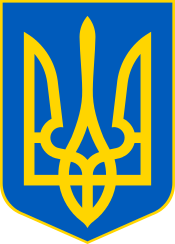
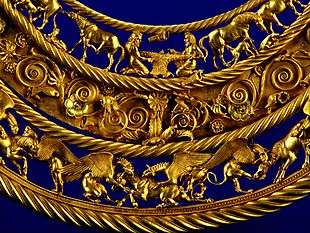
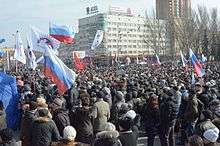

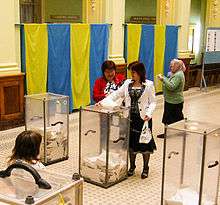
_03_cropped.jpeg)
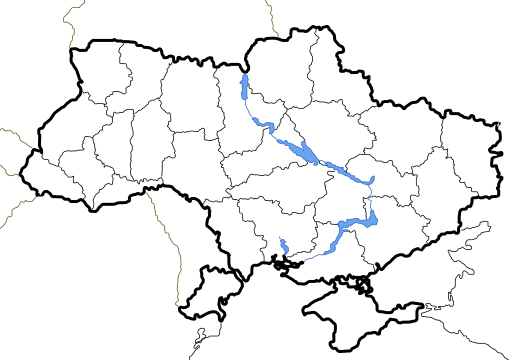

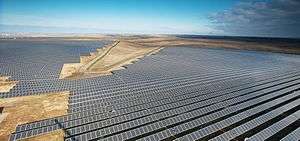



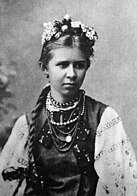
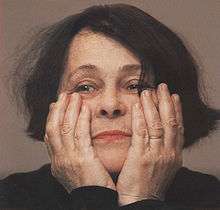
.svg.png)